

Writing a Video Book Report

Are you a student who has to write a book report on a recently read book or a teacher assigning a report as homework to your students, looking for a creative approach to mix things up?
Thinking back to the good old days in grade school, we can all probably recall having to write at least a few book reviews, right? And for the most part – those were done in a written format. But let’s stop here for a second and consider that it is indeed the 21 st century, and we do have a few more options now. One is using technology to aid traditional tasks, such as making a quality animated video using a video-creation tool like mysimpleshow. Not only does it encourage students to creatively engage outside of school, but it tackles different learning formats and serves as an alternative to regular homework. Thus, students can improve their organizational skills by applying their content knowledge in a creative matter that will foster retention while boosting interest.

The Benefits of Writing a Video Book Report
Videos have a much larger spectrum for learning opportunities than the regular written approach. Having to recreate the story and its components, the students work on their storytelling skills by embracing creativity. Furthermore, videos additionally offer the choice of visuals, which allow the students to think in symbols and thus requires them to show a deep understanding of the content. Videos don’t allow for endless keystrokes, compelling the students to stick to the key points and work to improve their skills of easy and simple explanation. For teachers, the benefits lie in the opportunity to flip the classroom and assign videos as homework or in-class activities. Videos consider and tackle different learning styles and promote independent working as well as research skills. They allow for a great sharing and presentation method available to all students. Check out this video book report on The Scarlet Letter: A Romance by Nathaniel Hawthorne:
How to Write a Video Book Report
After making sure that certain necessities such as a computer, internet connection, and images are available, everything you need to know about creating a video book report using mysimpleshow is below!
- After signing up with mysimpleshow and having activated your account you choose ‘My Videos,’ ‘Create New Video,’ and then ‘Write Your Own Script.’
- Luckily, the education templates already include ‘Summarize Literature or a Movie’ or ‘Interpret Literature or a Movie.’ You may choose one according to the assignment.
- Simply follow the video creation steps by writing the text for your review first before choosing suitable images to strengthen your message in the visualizing phase.
- Lastly, you have the choice of a voice over and the opportunity to preview your video and to make any last few adjustments before rendering it. Download and sharing options are available for your video.

Other Uses for Video Reports
You can have the students share the videos in the form of a presentation, or create smaller groups to look at each video, give feedback, and enhance requiring and sharing of knowledge in a creative way. Since the videos are short, you may want to consider assigning follow-up videos about key elements or students’ points of view. Videos don’t have to replace a written report, but may serve as an alternative or an asset to traditional assignments.
- BookWidgets Teacher Blog
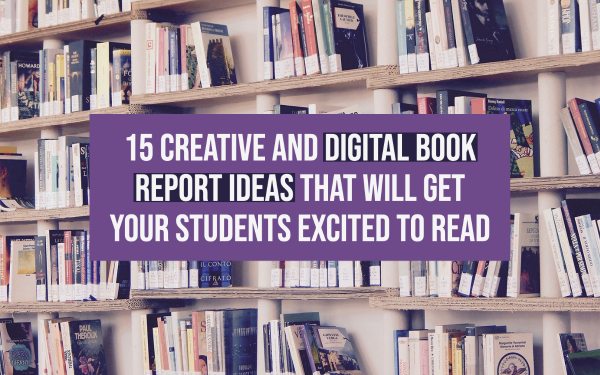
15 Creative and digital book report ideas that will get your students excited to read

Not all students are excited to read a book. So how can you make reading a book more engaging and fun? This is a huge challenge for most teachers, so I hope I can help you out!
Here’s what you’ll find in this blog post (click on the title if you want to jump to the section directly)
5 tips to get your students excited about reading
- 15 creative and digital book report lesson plans (free & ready to use!)
- The complete collection of book report lesson ideas in one assignment (your students get to choose!)
Instructions on how to use these digital book report lesson activities
Before you dive into the book reports, you have to get your students excited about reading first. In this previous post about reading, I’ve listed 10 tips that will encourage your students to read . I’ve come up with 5 more amazing tips! Here we go:
1. Use AR apps

Here are a few apps with amazing storylines and AR books.
- Wonderscope , for example, is an excellent storytelling tool. It uses augmented reality to transform ordinary places into real-time stories. Students also learn to read with the app. They ask questions to the characters in the story and listen to the characters’ answers.
- The Ghostkeeper’s journal and field guide : This book is an immersive adventure for readers aged 10 and up, offering several AR experiences to enhance the storyline. These are accessed via a mobile app “ Ghost-o-Matic ”.
- Bookful creates an engaging reading experience and brings stories and characters in books to life. The app holds the world’s largest 3D/AR library with hundreds of titles from leading publishers and brands such as: The Tale of Peter Rabbit, DK’s Encyclopedia, and children’s favorites such as Barbie, My Little Pony, Thomas & Friends, Transformers, and The Smurfs.
2. Escape lessons

Here are 3 fun ready-to-use escape lessons to spark your students’ joy of reading:
- A Halloween Murder : Let your students investigate the murder of the victim: Brat Spook. When they find the murderer, they get their “inspector” badge. Let them look for evidence in the murder scene, talk to suspects, analyze lab results, and so on!
- Finding Rudolph : Save Christmas by helping Santa find back Rudolph. Students go through different challenges, talk to eye-witnesses, and follow Rudolph through a winter maze, so Santa can deliver all the presents to the children.
- Easter Bunny Substitute : Can your students find a good Easter Bunny replacement? In the last breakout game for the classroom, the Easter Bunny is hurt, so your students need to interview the possible applicants and take tests to replace the Easter Bunny themselves. If they succeed in the challenges, they get an Easter Bunny substitute badge.
3. Storytelling

If you bring cultural elements into your lessons by telling a story, your students will be more eager to learn. Storytelling makes students want to “live the story”. And they do this by reading it. If your story is strong enough, your students will love learning and reading. They will even remember the lesson content better.
Here’s a fun & ready-to-use example: The life of William Shakespeare
4. First chapters

5. Books & sleepovers

You can even add different parts to your sleepover. For example, let students read their favorite passage in a book of choice out loud, and 1 hour before bedtime, all your students take their book and read in silence. Or how about creating cozy themed corners? Fantasy, science fiction, detectives,… When your students are reading in themed corners, they get the full experience. They can even dress up as a character in their book whilst reading.
15 Creative and digital book report lesson plans
Step 1: Get your students excited about reading. ✅ Step 2: make sure they don’t lose their interest when you’re announcing the book report assignment! ☑️ This part can be demotivating.
As the lower grade students often still get fun book report assignments, the higher grade students often get a dull worksheet where they have to describe the characters and give a summary. Change up your book report assignments with these creative, free & ready-to-use lesson ideas.
Take a look at all these ready-to-use and free digital book report activities. They’re all made with BookWidgets . You can even make exercises like these yourself in your own BookWidgets account.
Keep on reading to find out how to use these exercises in your lessons.
How did your students experience the book? Let them fill the glasses with drawings of the storyline/the book. The glasses represent the view of the students. Students can get really creative and use the toolbar at the bottom to draw and type.
You can ask your students to present their book report artworks to the other students as well. This way, your students can explain what’s on their drawing.
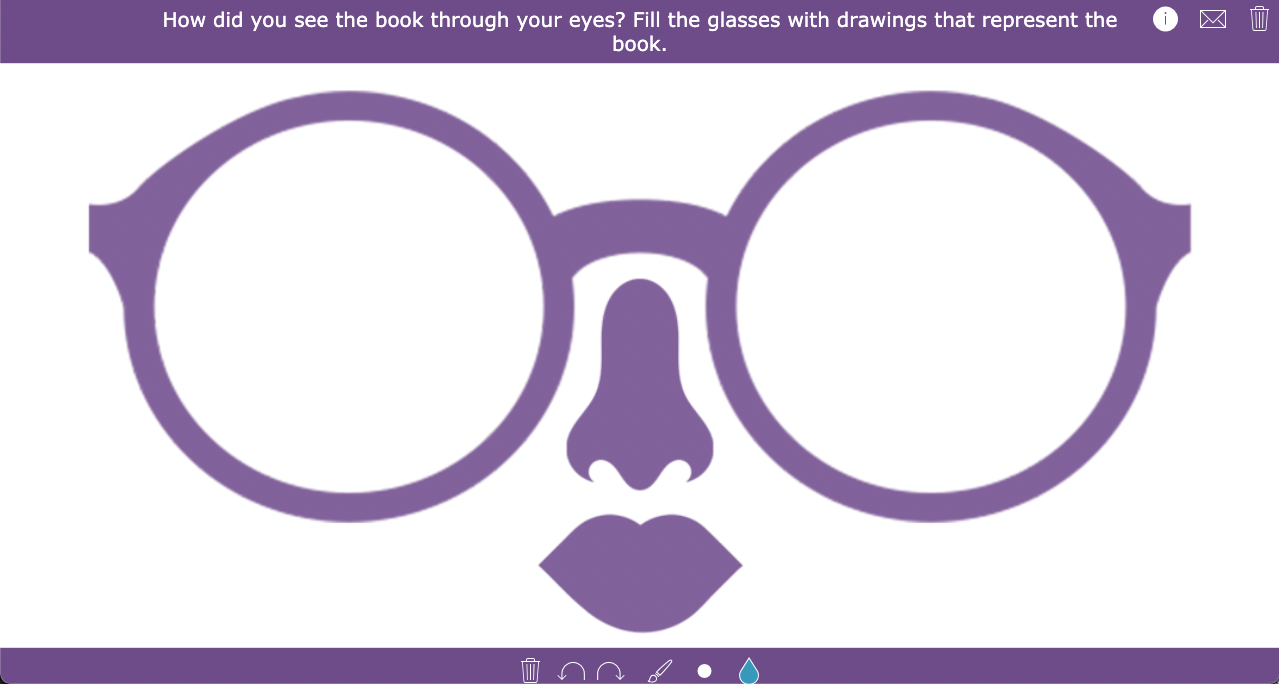
2. Bookworm
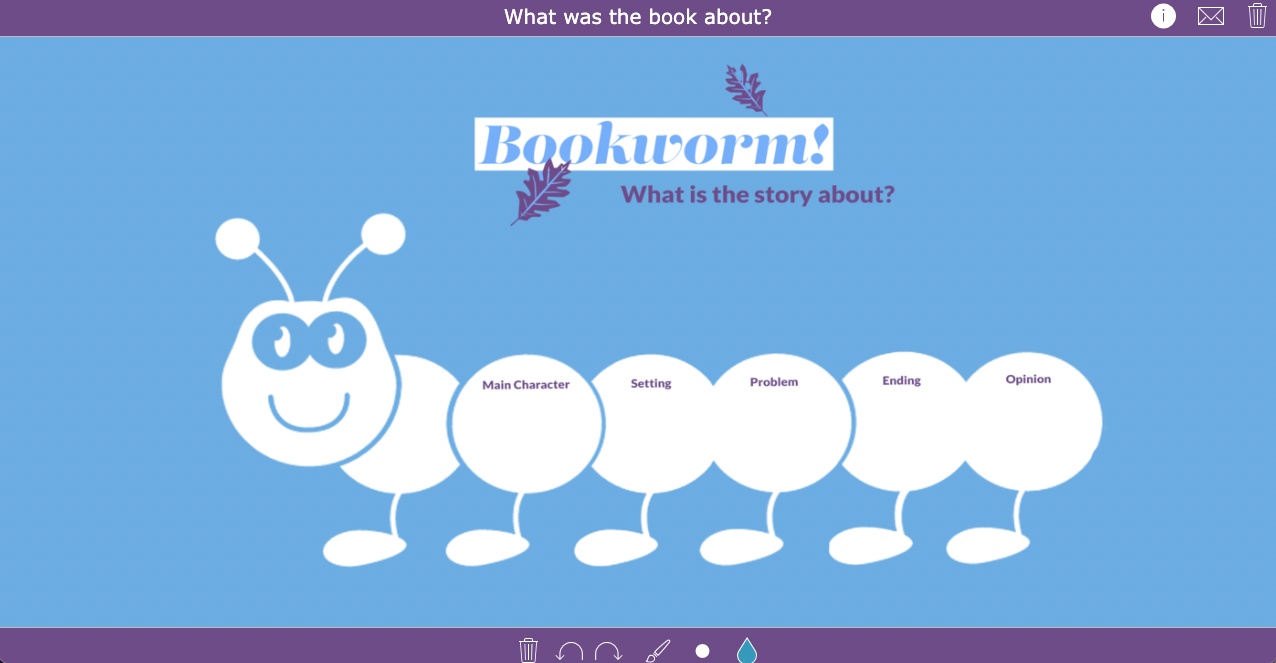
3. Timeline
This interactive book report asks your students to create a timeline of the story. When did what happen, chronologically? The have to add the biggest events in the story to the timeline.
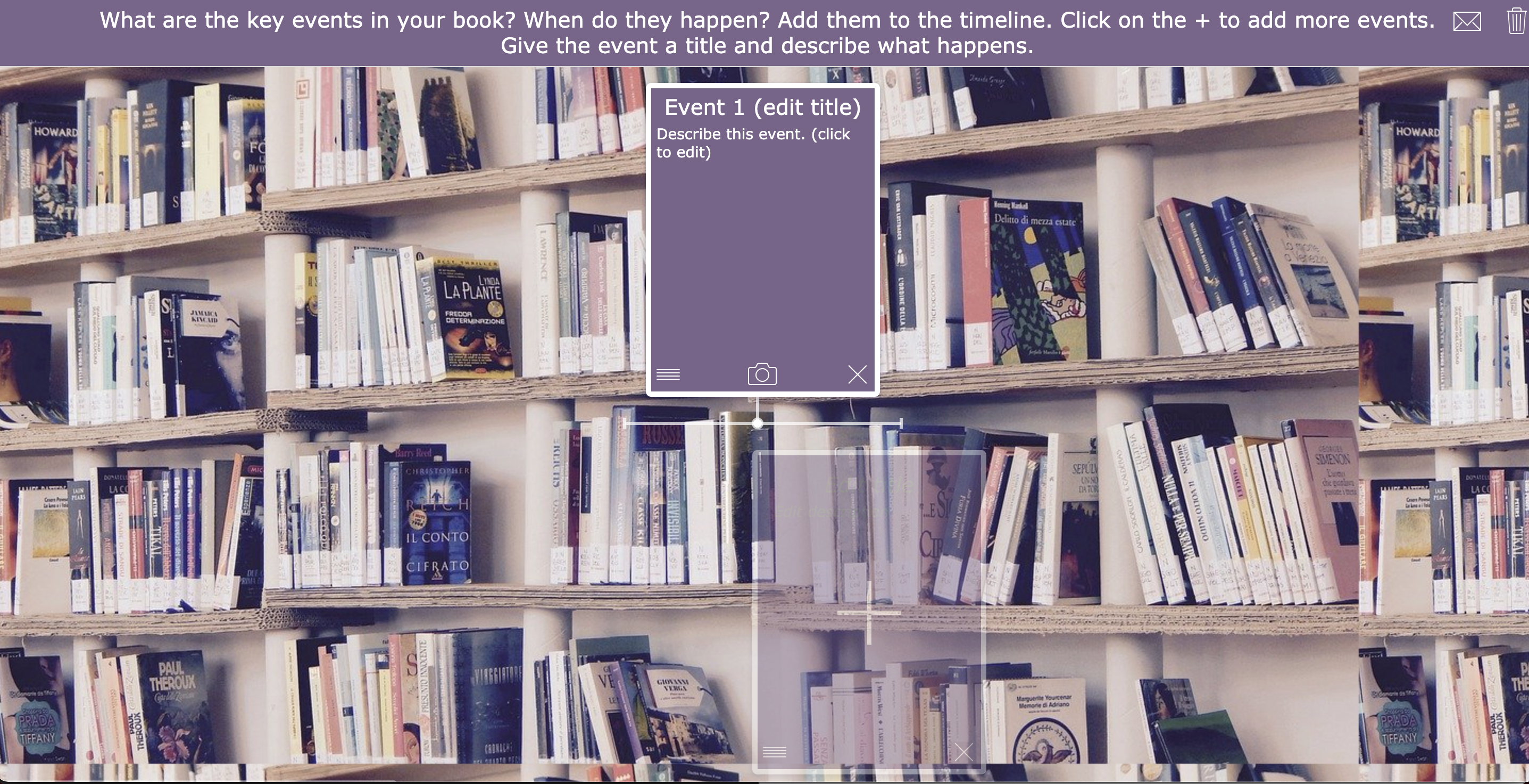
4. Comic book
In this book report exercise, your students have to write a comic book based upon the book they’ve just read. When they click on the “start” icon, they can choose fitting text balloons to go with their story.
Here are three other fun websites that let students create comic books: Storyboard That , Comic Life , and Toonytool . They already give you creative templates and drawings. This is a bit easier for students. This way, they don’t have to start from scratch.
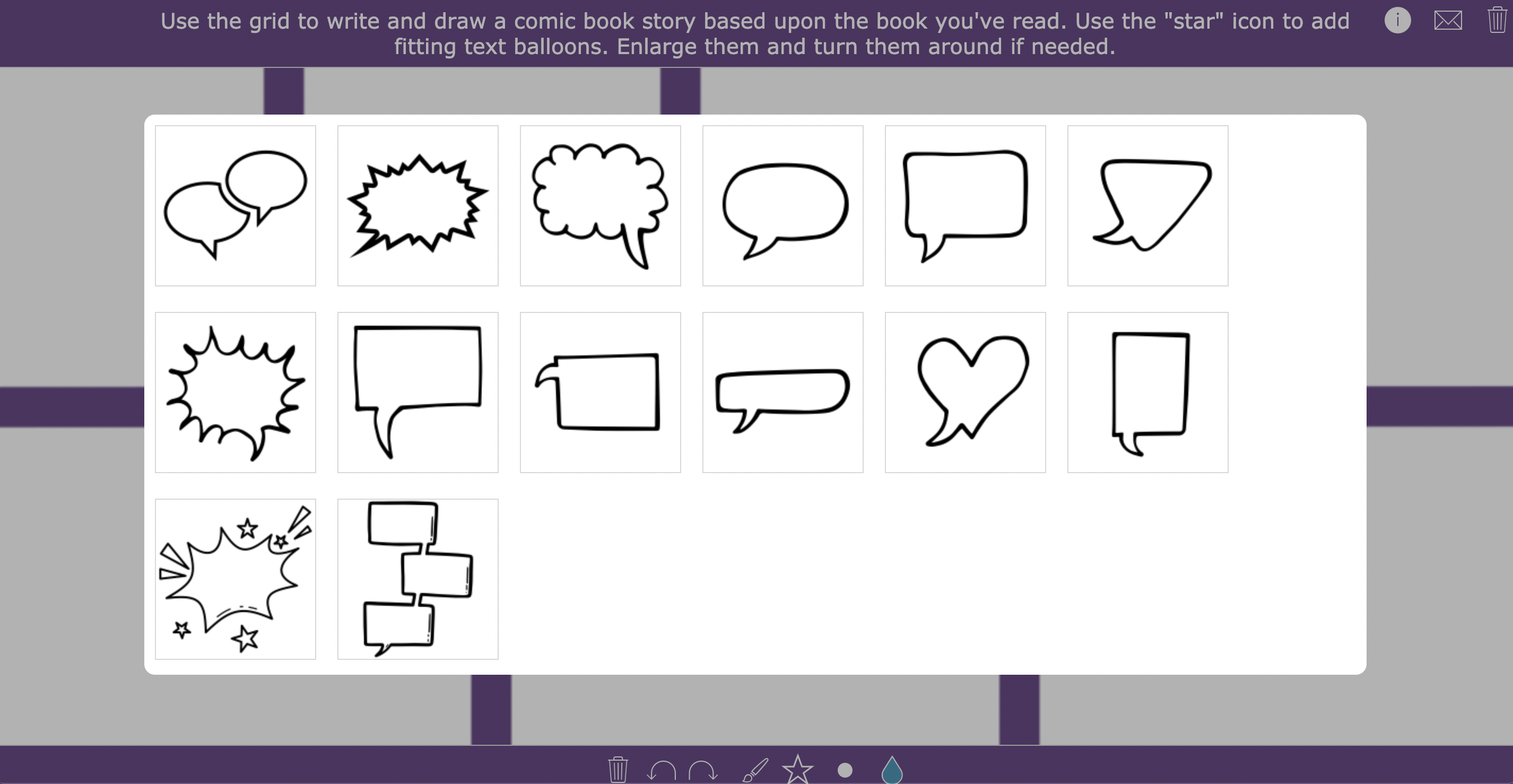
5. Character portrait
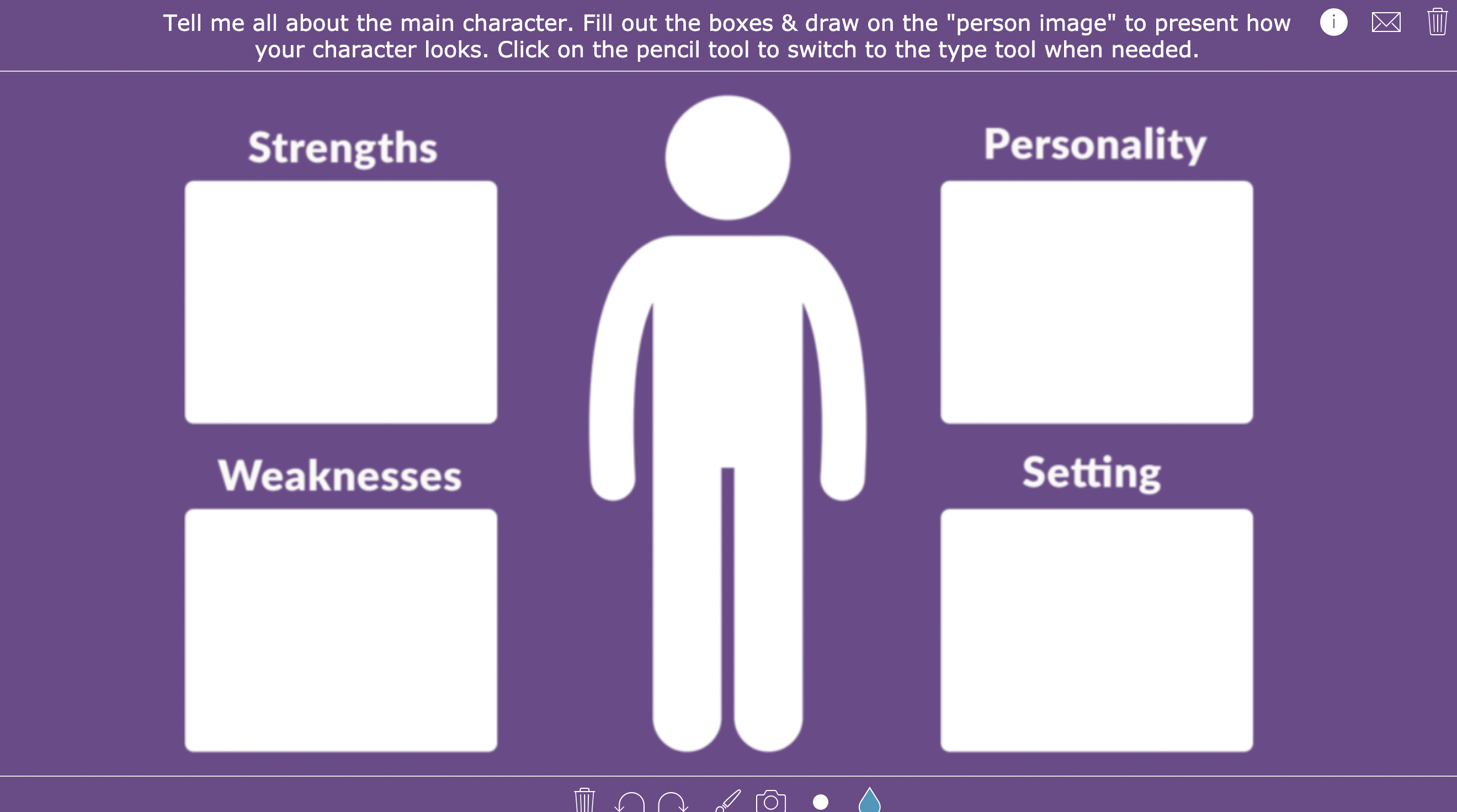
6. Randomness task
Just… add a little spice. I’ve turned the ordinary book report task, where students have to describe characters, the setting, plot, etc., into an exciting one. Your students don’t know yet what they’ll have to describe. They spin the randomness wheel and their task appears. The fun thing about this one is that all of your students will write a different book report.
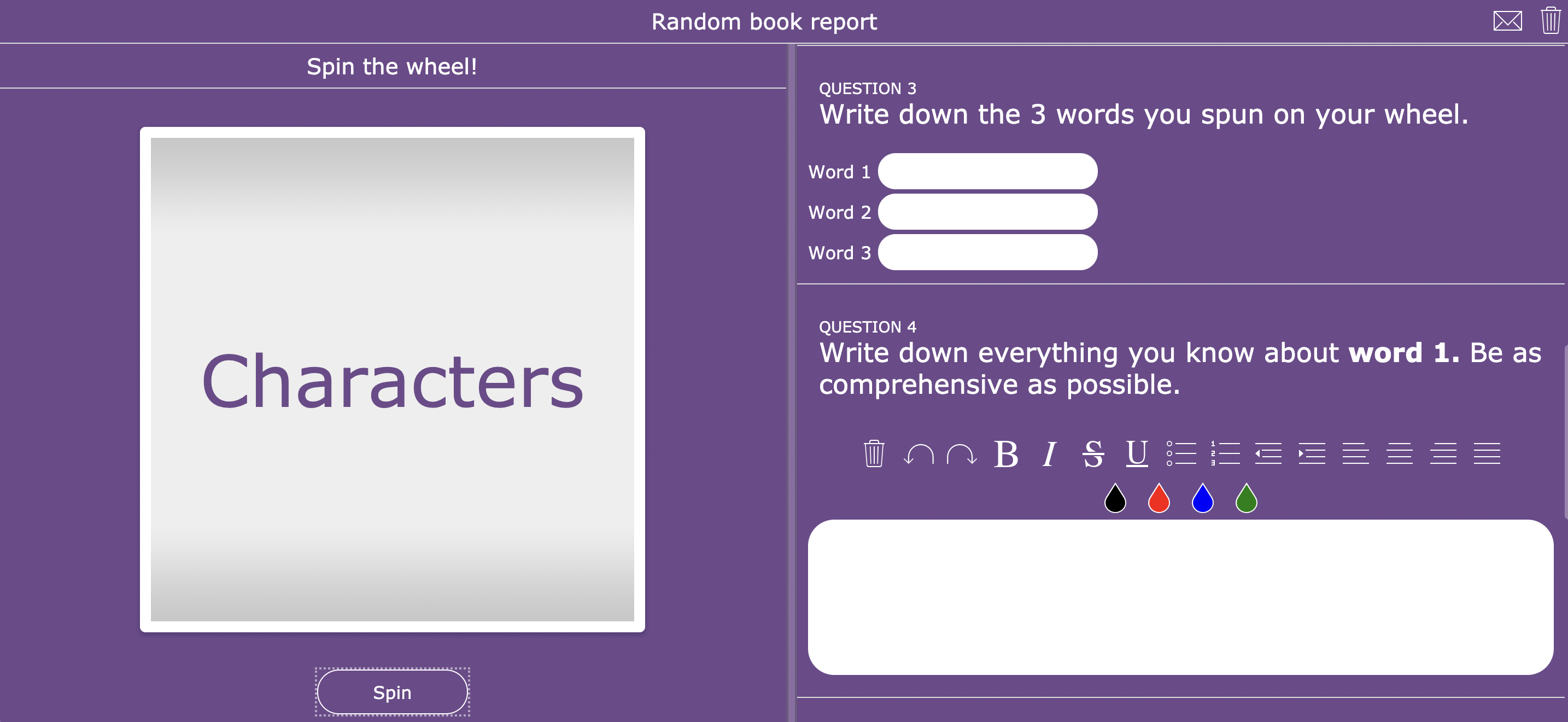
7. Book cover
Here, students get to be creative and invent their own book cover (front and back) of the book they just read. Or maybe just a cover for of a piece of text you’ve read out loud. They can use the whiteboard tools: pencil, type tool, switch colors, add images, etc.
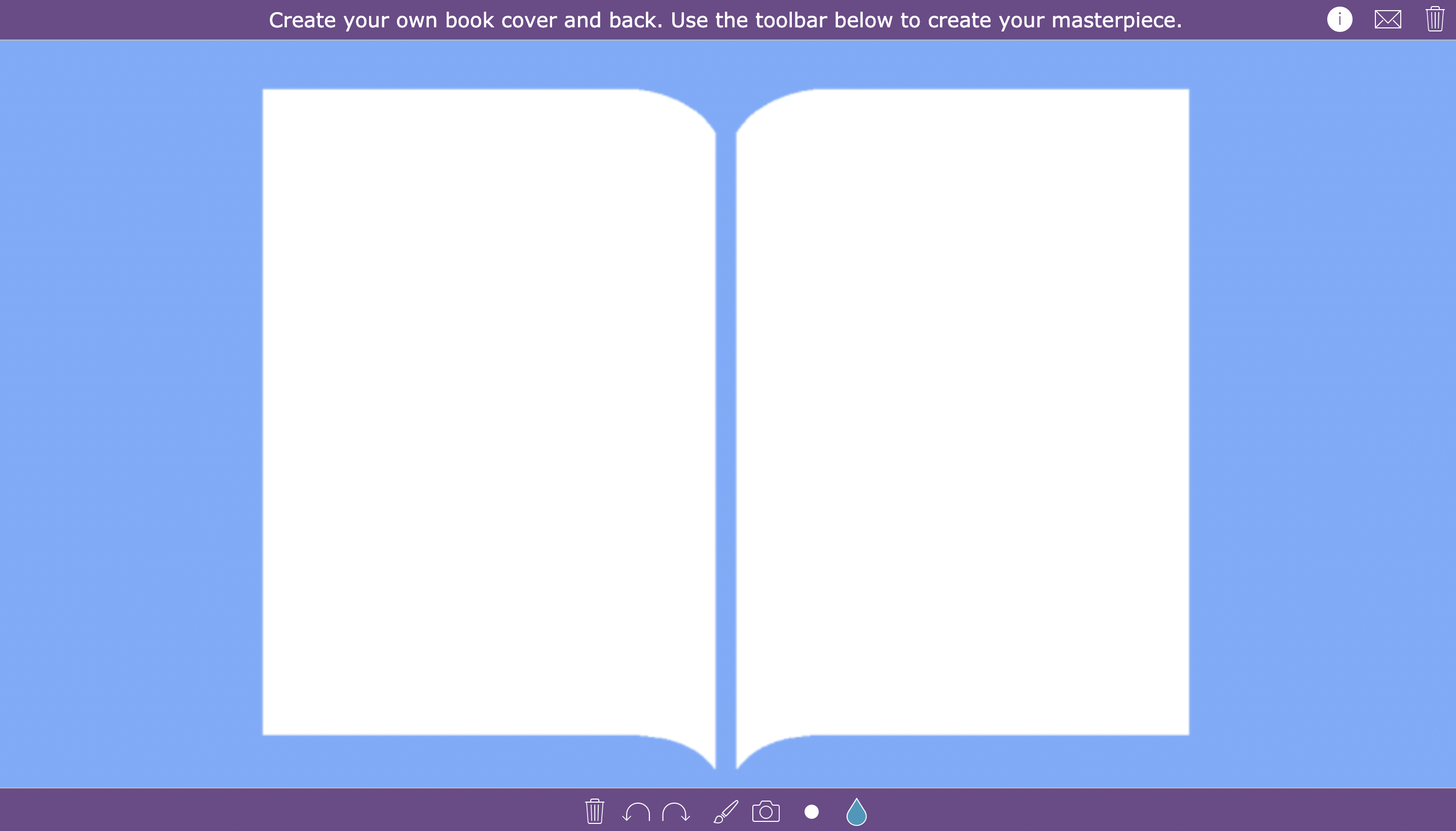
8. Character family tree
This digital mind map exercise allows your students to add boxes with text and connect them to each other. This is perfect for a book report activity focusing on the characters in their book.
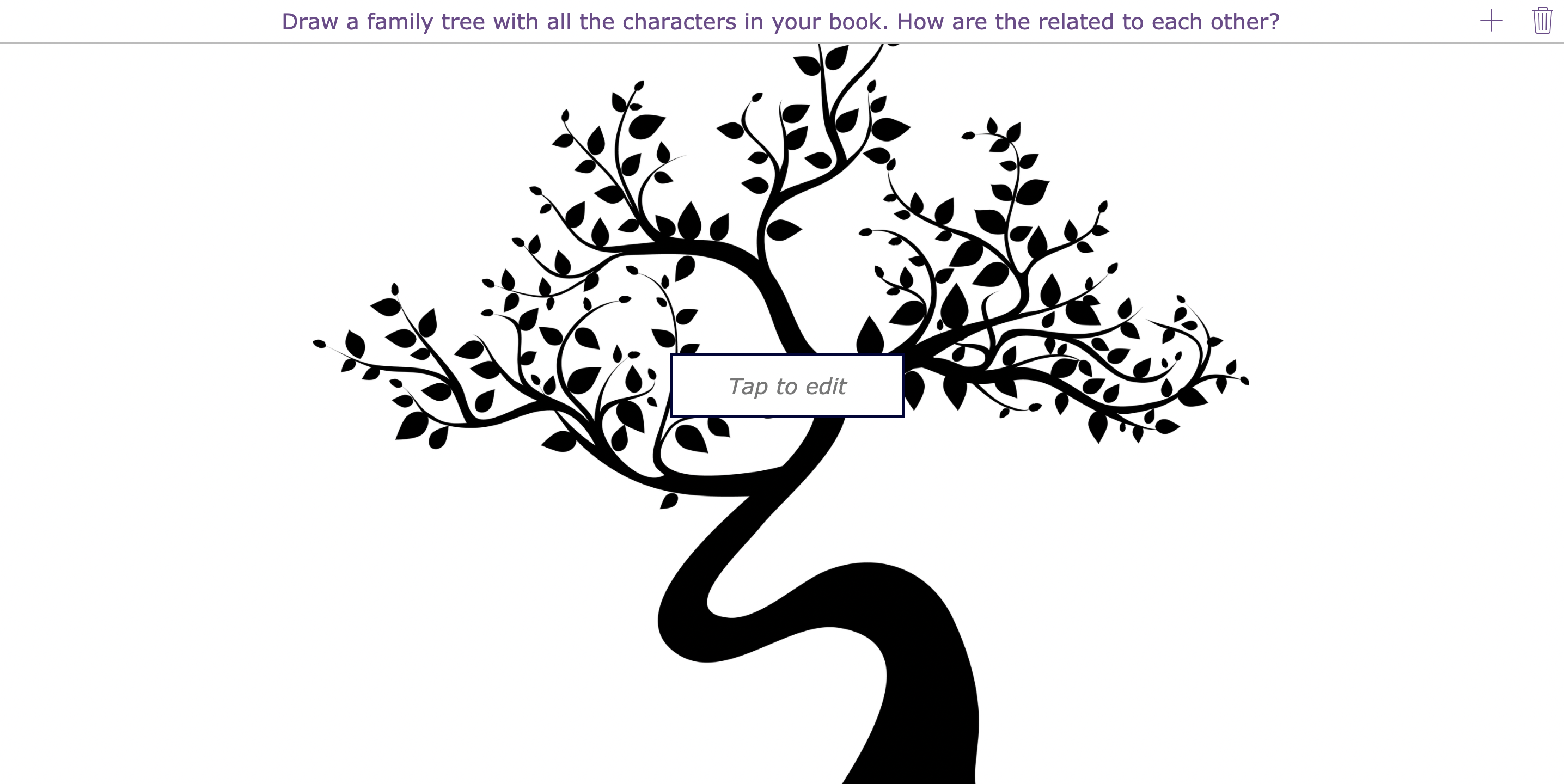
9. Facebook Profile
Modern days call for modern book report lesson ideas. Image the main character having a Facebook profile. What would be on it? That’s exactly what your students have to figure out here. Create a Facebook profile about the main character.
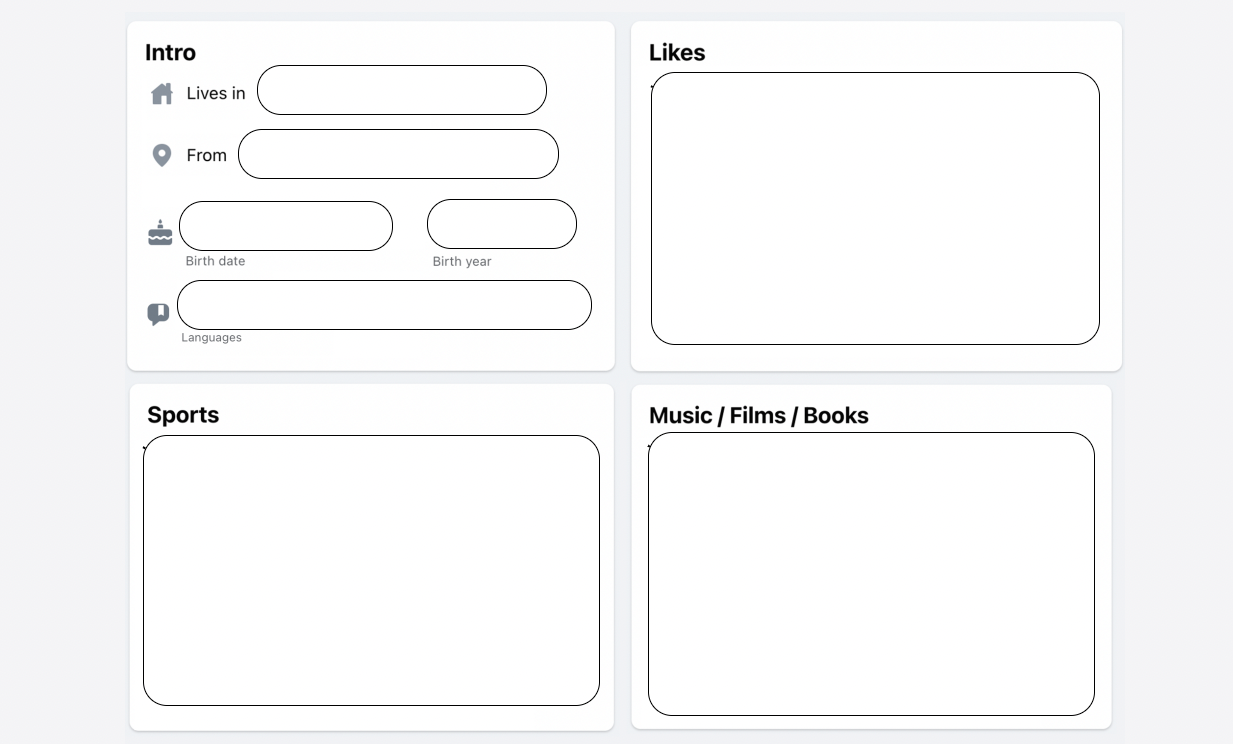
10. Book Collage
Here, students have to add 10 pictures or images that have to do with the book. They can do so by clicking on the photo icon and adding images into their collage.
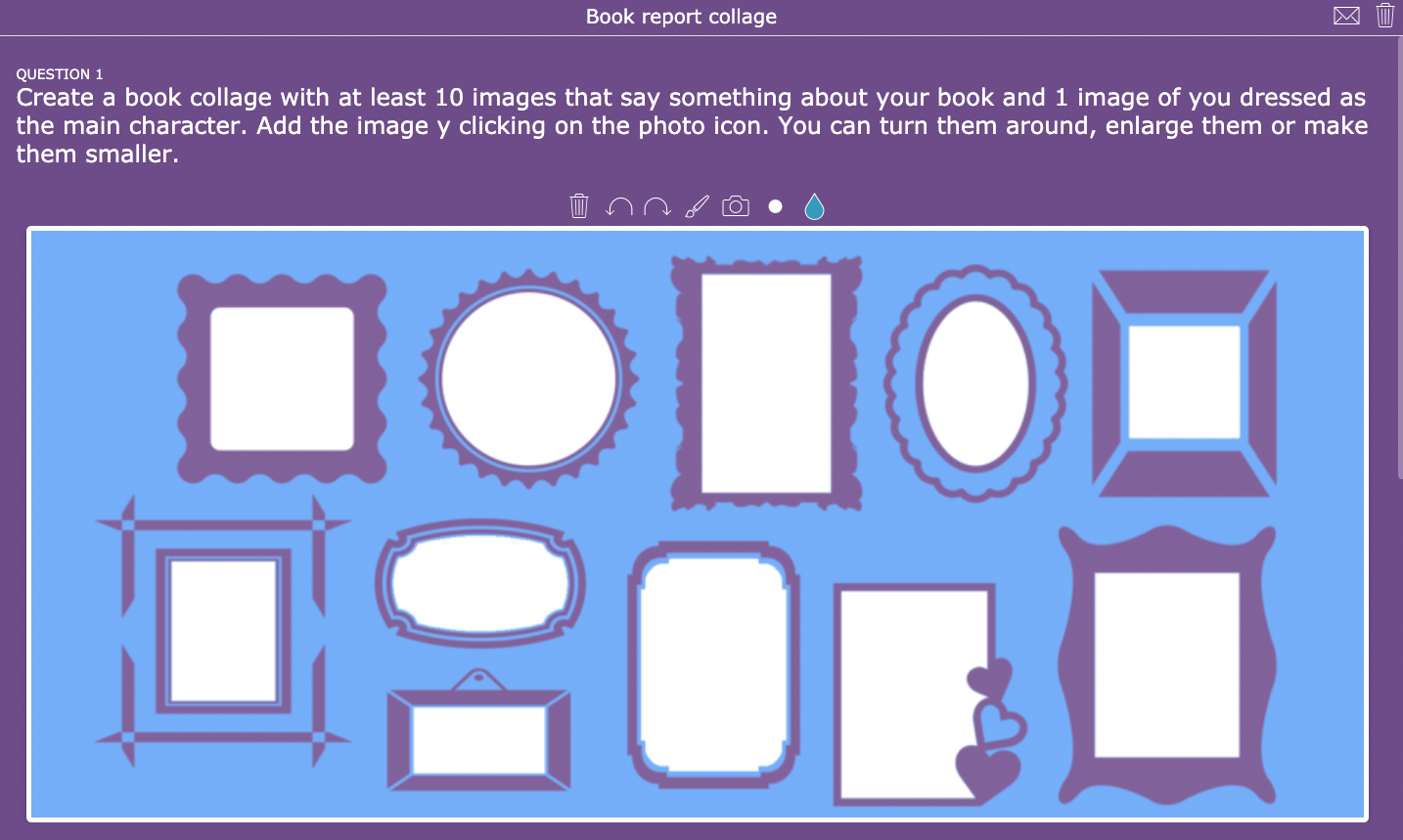
11. Mirror selfie
In this creative book report, students have to dress up like the character in their book, including holding 3 attributes that refer to the personality of the main character. They have to take a picture or mirror selfie of themselves dressed up, and add that picture to the whiteboard. You can ask them to come forward and present their images and explain why they’ve chosen those specific attributes.
The fun thing about all of these exercises is that they work on smartphones as well. So in this case, students can just open the exercise on their smartphones, take a mirror selfie with their phones and add it to the mirror in the digital whiteboard exercise.
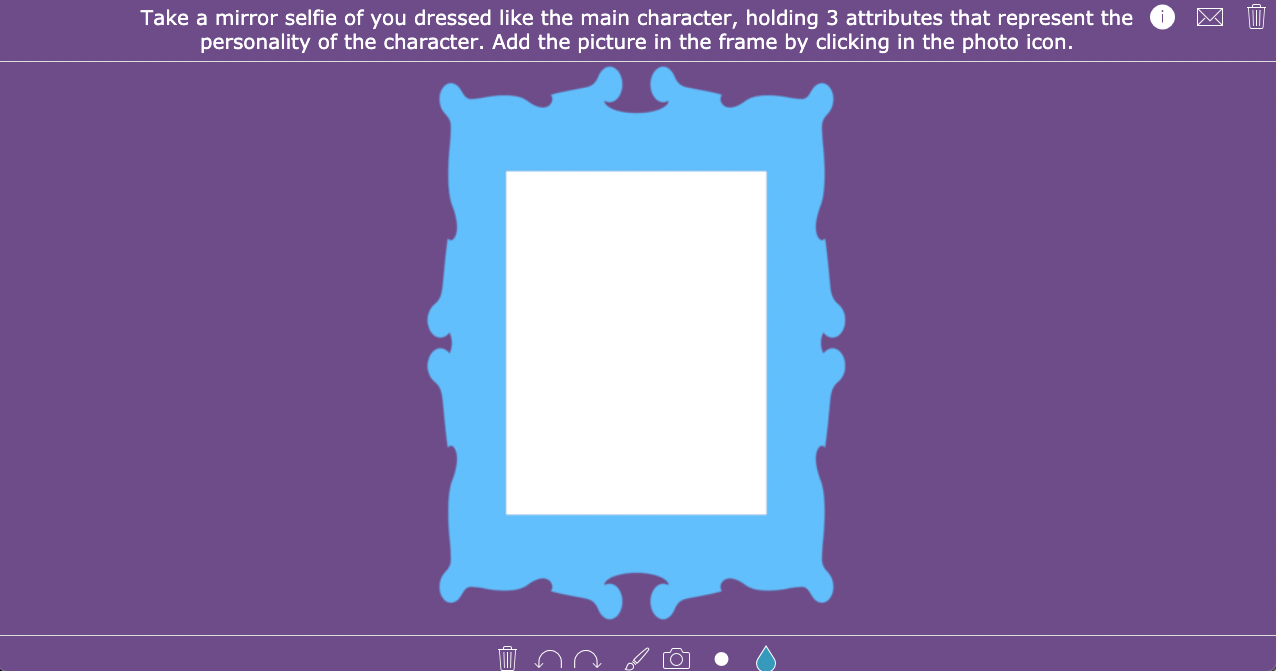
12. Email to the author
Your students have the chance to write a friendly email or letter to the author of the book they just read. Students have to share:
- their opinion;
- the character in the book they liked most, and why;
- their favorite part of the book and why;
- questions that they have about the book.
If you have an email address of the author, ask your students to submit their works to you, the teacher, first. After having given feedback on their letters, they can make some changes and send it over to the author.
If you have the author’s postal address, it’s much more fun to write a classic letter.
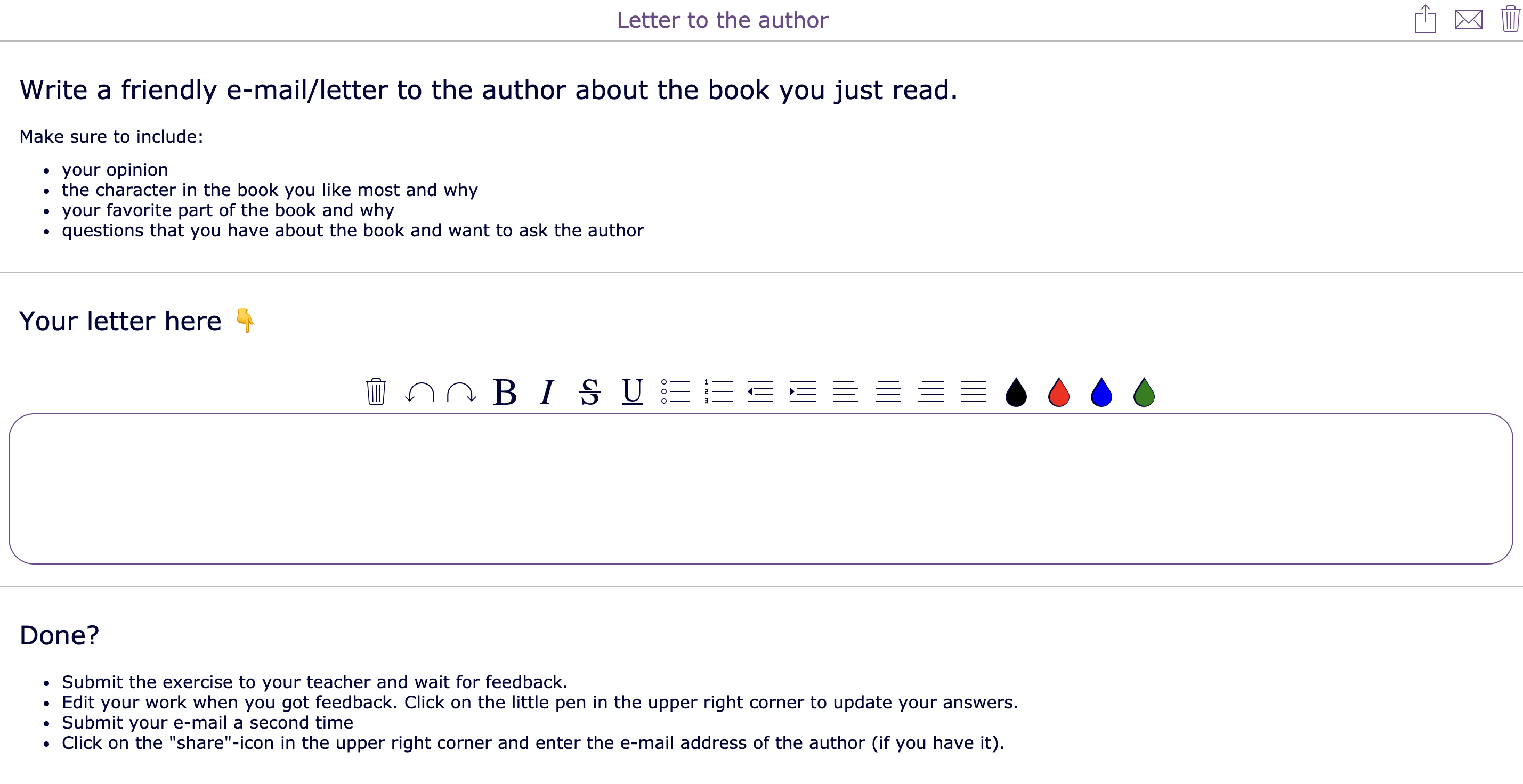
13. Conversation between characters
There is something called a “texting thumb” or a “smartphone pinky”. This shows that students like to send texts. A lot of them. So why not include it in your book report lesson plan? In this digital book report, students have to invent a conversation between two characters in their book.
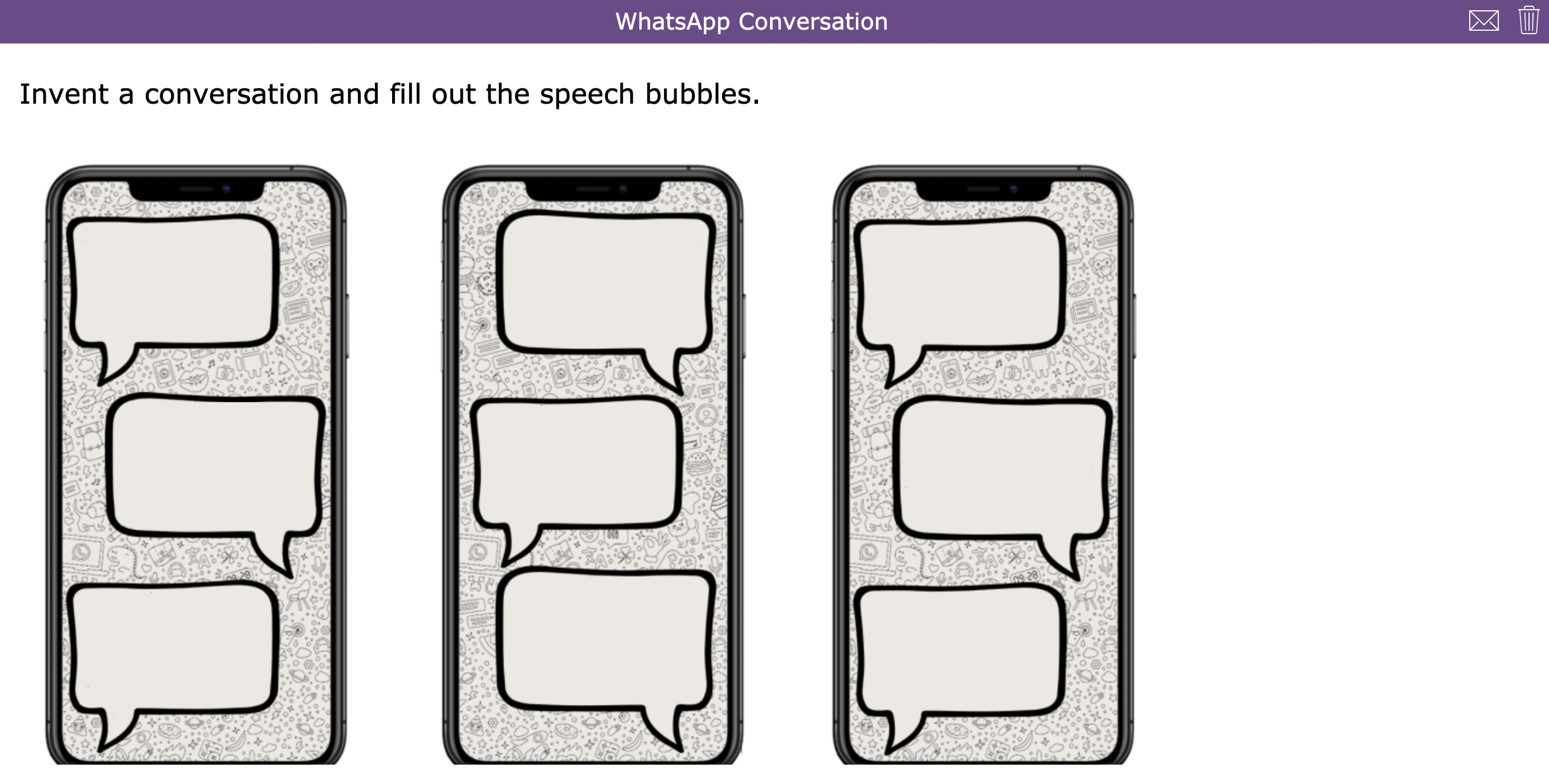
14. Movie vs. Book
A lot of books have a movie version too. If your students choose a book that also has a movie, it’s interesting to let your students make a comparison. With this book report exercise, you’re also sure your students actually read the book instead of just watching the movie and write a summary of the movie and not the book.
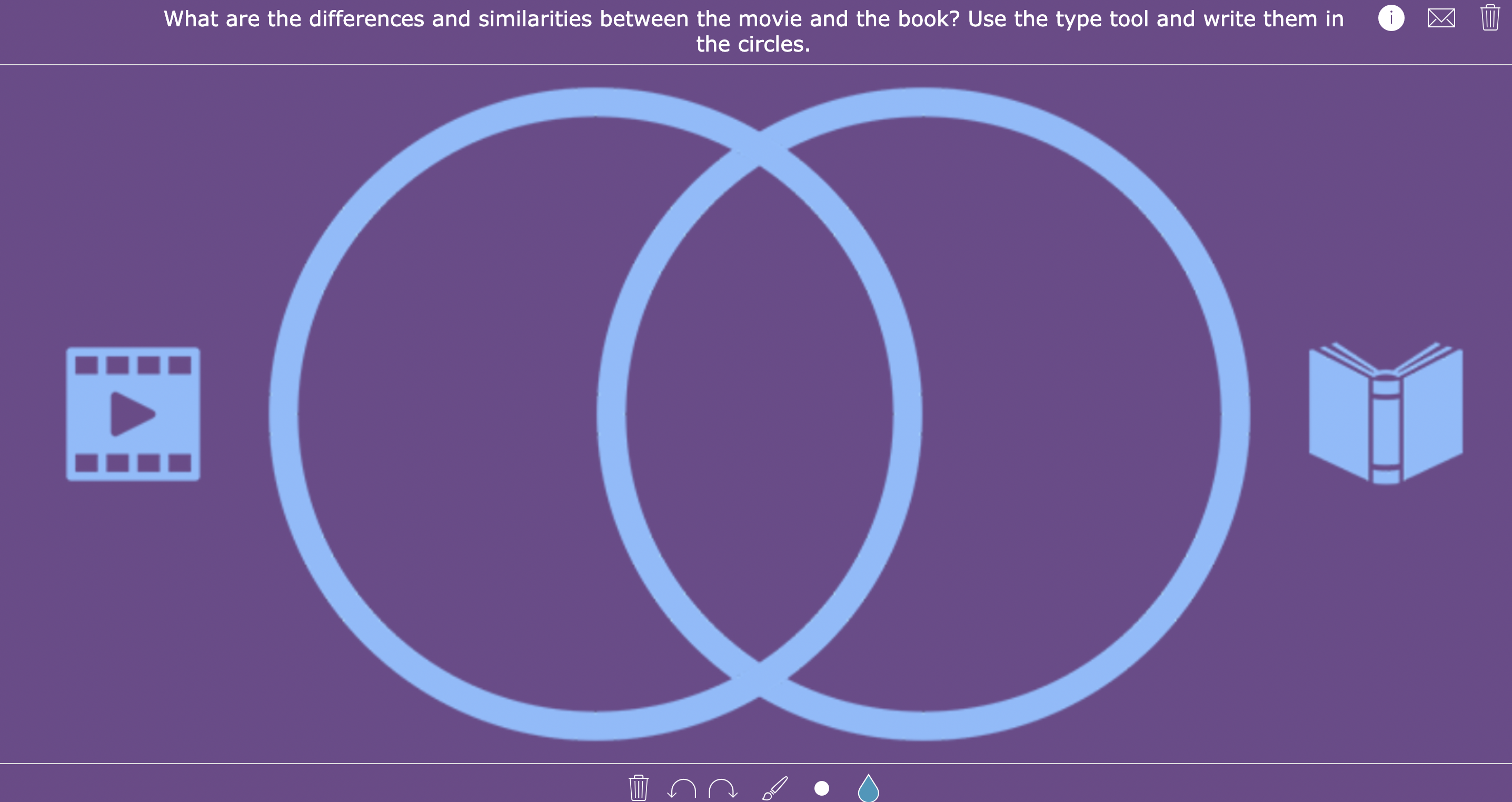
15. Emoji summary
The last exercise is also one students can relate to. Nowadays, we use emojis after almost every sentence when we’re communicating with friends. Emojis also have a strong meaning and can be used to express feelings or say something without actually saying it.
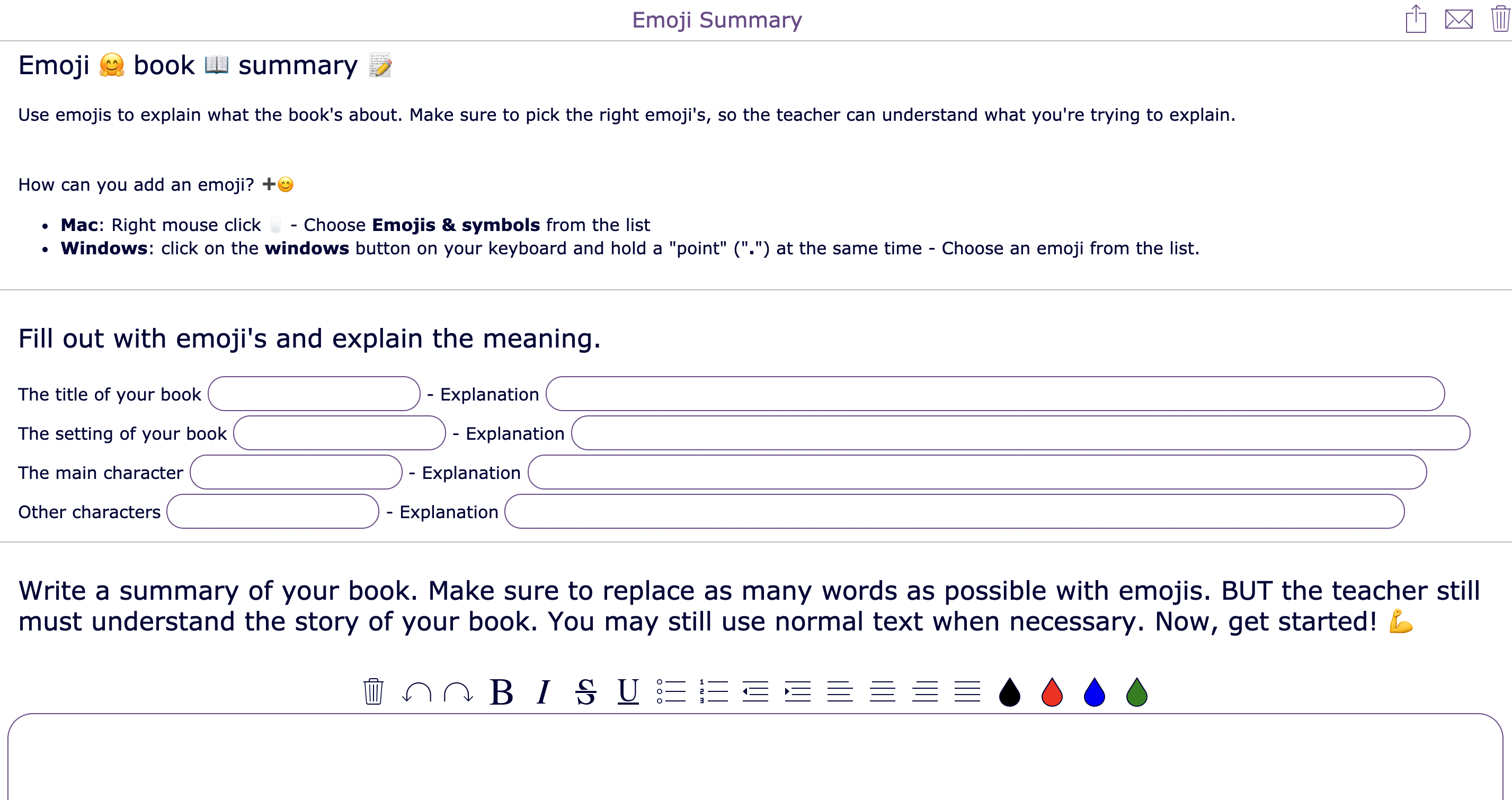
The complete collection of book report lesson ideas in one assignment
All these book report exercises are so much fun and yet they don’t take up a lot of time. Perhaps they just ask your students to only describe a certain part about the book. Cue… the planner widget.
With this type of BookWidgets activity, you can combine several lessons into one. You can let your students take matters into their own hands and choose which book report activities they’d like to finish.
It’s actually pretty easy. Your students read the instructions in the instructions widget and then start adding at least three book report activities to their planner. They finish the activities, submit them to their teacher, check off their planner, and that’s it!
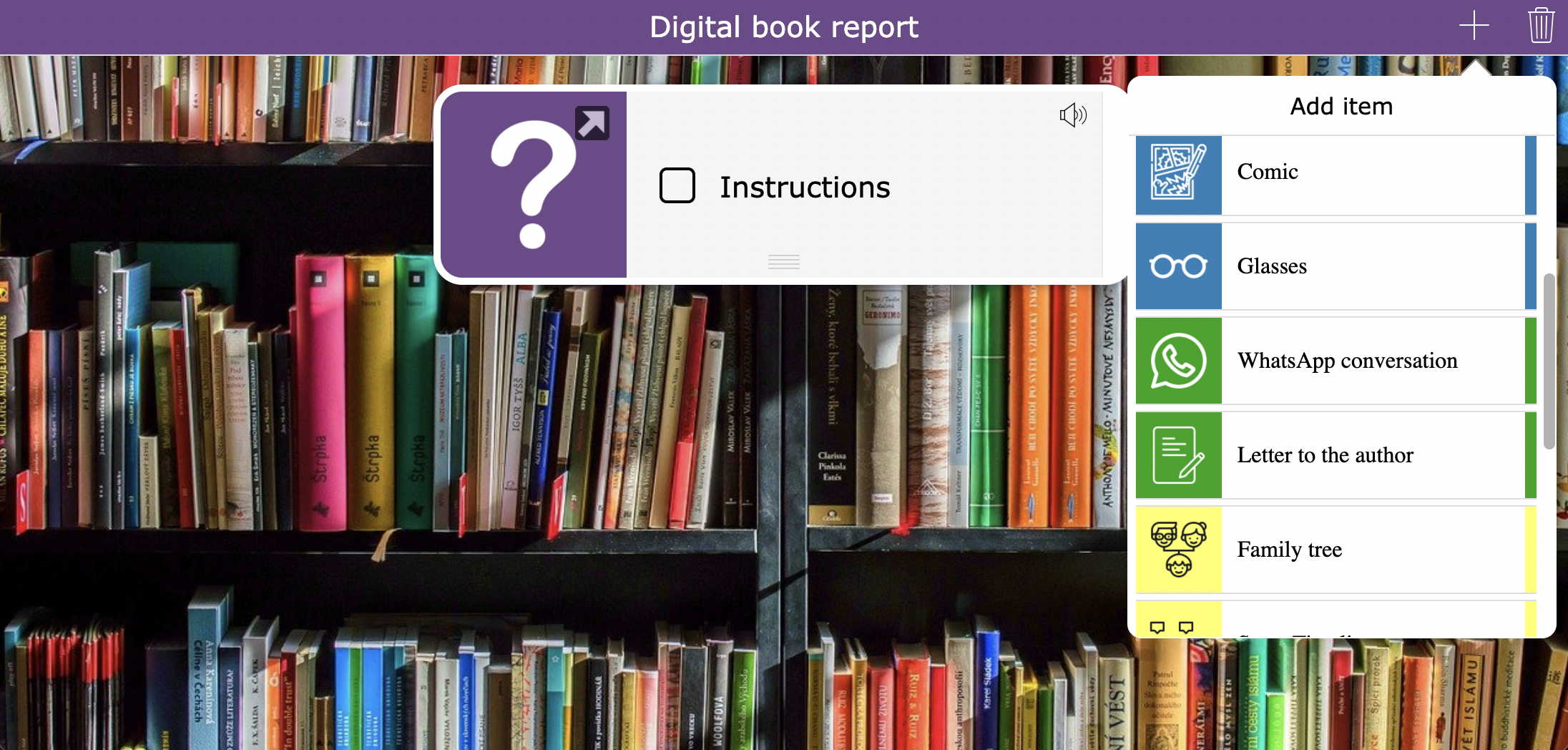
Above, you can find the 15 ready-to-use book report activities. You can use these lesson examples for free. Since they’re all made with BookWidgets, I’ve listed them in this BookWidgets group . Here’s what you need to do:
- Click on this link . It will immediately bring you to the group with all of the book report activities. If you don’t have a BookWidgets account yet, you’ll have to sign up first for free .
- Duplicate all the book report activities. Click on the settings wheel , select all widgets , click on the settings wheel again, choose duplicate selected widgets . Choose where you want to save the activities in your BookWidgets account.
- Go to your saved book report lessons. You can now click on the black dropdown arrow next to the ‘Show’ button of a particular exercise and select Edit . You can make some changes to this activity (if you want). If it’s perfect for you, click on Share in the upper right corner.
- Share this link with your students. When they click on it, they can fill it out. A lot of the book report examples above have been made with BookWidgets’ Whiteboard widget, in which students can use the tool menu at the bottom to switch tools (draw, type,…), and to switch colors. When done, they can submit the book reports to you by clicking on the envelope in the upper right corner.
- As a teacher, you go to “Grades & reporting” in BookWidgets to find your students’ answers.
Of course, now that you’ve got your own BookWidgets account, you can also create book report activities or other assignments yourself!
Attention! Once your free trial runs out, you’ll only be able to use the widgets you’ve already finished/shared with students. While your BookWidgets account will still work and you’ll still get your students’ results with the free BookWidgets version, you won’t be able to duplicate widgets nor create new widgets yourself anymore.
So that’s it! I hope these lesson ideas are useful for your classroom or at least give you lots of new ideas for your book report lessons! You can even create ones yourself!
Create your first digital book report with BookWidgets
Have fun, share this with fellow teachers and keep on rocking your classroom!
Join hundreds of thousands of subscribers, and get the best content on technology in education.
BookWidgets enables teachers to create fun and interactive lessons for tablets, smartphones, and computers.

- Integrations
- Adobe Photoshop
- Higher Education
Internal Comms
- Remote Work
SIGN UP FREE
- Sign up free
Book Report Template - Animated Style
Template transcript, book reports arrive in the 21st century with this modern video template, a new twist on a classic assignment. the ability to report on what they read is key to a student's success in school and life. all the more so with video use this awesome video book report template to get all your students' senses excited by transforming lame, written book reports into movies great for individual student assignments or group projects., remote & office, remote learning, virtual events.
- Sales Meetings
- Company-Wide Gatherings
- College Opening Days
- Trade Shows/Conferences
- Marketing Strategy
- Social Media
- Lead Generation
- Explainer Videos
- Product Marketing
- Marketing Reports
- Prospect Management
- Lead Nurturing
- Customer Onboarding
- Client Engagement
- Upselling Customers
- Sales Reports
- Sales Materials
- Product Training
- Company Compliance
- Workplace Policies
- Digital Transformation
- Employee Training
Learning & Development
- Workplace Communication
- Compliance & Guidelines
- Employee Wellbeing & Events
- Project Management
- Change Management
- Employee Recruiting
- Employee Onboarding
- Employee Performance
- HR Workplace Communication
- HR Compliance & Guidelines
- HR Employee Wellbeing & Events
- Administrative Staff
- Teachers & Faculty
- Student Projects
Holidays & Events
- Digital Marketing
- Financial Services
- Real Estate
- Health & Fitness
- Beauty & Care
Categories - All
Choose a template to create an awesome video in minutes

How to Write a Book Report
Use the links below to jump directly to any section of this guide:
Book Report Fundamentals
Preparing to write, an overview of the book report format, how to write the main body of a book report, how to write a conclusion to a book report, reading comprehension and book reports, book report resources for teachers .
Book reports remain a key educational assessment tool from elementary school through college. Sitting down to close read and critique texts for their content and form is a lifelong skill, one that benefits all of us well beyond our school years. With the help of this guide, you’ll develop your reading comprehension and note-taking skills. You’ll also find resources to guide you through the process of writing a book report, step-by-step, from choosing a book and reading actively to revising your work. Resources for teachers are also included, from creative assignment ideas to sample rubrics.
Book reports follow general rules for composition, yet are distinct from other types of writing assignments. Central to book reports are plot summaries, analyses of characters and themes, and concluding opinions. This format differs from an argumentative essay or critical research paper, in which impartiality and objectivity is encouraged. Differences also exist between book reports and book reviews, who do not share the same intent and audience. Here, you’ll learn the basics of what a book report is and is not.
What Is a Book Report?
"Book Report" ( ThoughtCo )
This article, written by a professor emeritus of rhetoric and English, describes the defining characteristics of book reports and offers observations on how they are composed.
"Writing a Book Report" (Purdue OWL)
Purdue’s Online Writing Lab outlines the steps in writing a book report, from keeping track of major characters as you read to providing adequate summary material.
"How to Write a Book Report" ( Your Dictionary )
This article provides another helpful guide to writing a book report, offering suggestions on taking notes and writing an outline before drafting.
"How to Write a Successful Book Report" ( ThoughtCo )
Another post from ThoughtCo., this article highlights the ten steps for book report success. It was written by an academic advisor and college enrollment counselor.
What’s the Difference Between a Book Report and an Essay?
"Differences Between a Book Report & Essay Writing" ( Classroom)
In this article from the education resource Classroom, you'll learn the differences and similarities between book reports and essay writing.
"Differences Between a Book Report and Essay Writing" (SeattlePi.com)
In this post from a Seattle newspaper's website, memoirist Christopher Cascio highlights how book report and essay writing differ.
"The Difference Between Essays and Reports" (Solent Online Learning)
This PDF from Southampton Solent University includes a chart demonstrating the differences between essays and reports. Though it is geared toward university students, it will help students of all levels understand the differing purposes of reports and analytical essays.
What’s the Difference Between a Book Report and a Book Review?
"How to Write a Book Review and a Book Report" (Concordia Univ.)
The library at Concordia University offers this helpful guide to writing book report and book reviews. It defines differences between the two, then presents components that both forms share.
"Book Reviews" (Univ. of North Carolina)
The University of North Carolina at Chapel Hill’s writing guide shows the step-by-step process of writing book reviews, offering a contrast to the composition of book reports.
Active reading and thoughtful preparation before you begin your book report are necessary components of crafting a successful piece of writing. Here, you’ll find tips and resources to help you learn how to select the right book, decide which format is best for your report, and outline your main points.
Selecting and Finding a Book
"30 Best Books for Elementary Readers" (Education.com)
This article from Education.com lists 30 engaging books for students from kindergarten through fifth grade. It was written by Esme Raji Codell, a teacher, author, and children's literature specialist.
"How to Choose a Good Book for a Report (Middle School)" (WikiHow)
This WikiHow article offers suggestions for middle schoolers on how to choose the right book for a report, from getting started early on the search process to making sure you understand the assignment's requirements.
"Best Book-Report Books for Middle Schoolers" (Common Sense Media)
Common Sense Media has compiled this list of 25 of the best books for middle school book reports. For younger students, the article suggests you check out the site's "50 Books All Kids Should Read Before They're 12."
"50 Books to Read in High School" (Lexington Public Library)
The Lexington, Kentucky Public Library has prepared this list to inspire high school students to choose the right book. It includes both classics and more modern favorites.
The Online Computer Library Center's catalogue helps you locate books in libraries near you, having itemized the collections of 72,000 libraries in 170 countries.
Formats of Book Reports
"Format for Writing a Book Report" ( Your Dictionary )
Here, Your Dictionary supplies guidelines for the basic book report format. It describes what you'll want to include in the heading, and what information to include in the introductory paragraph. Be sure to check these guidelines against your teacher's requirements.
"The Good Old Book Report" (Scholastic)
Nancy Barile’s blog post for Scholastic lists the questions students from middle through high school should address in their book reports.
How to Write an Outline
"Writer’s Web: Creating Outlines" (Univ. of Richmond)
The University of Richmond’s Writing Center shows how you can make use of micro and macro outlines to organize your argument.
"Why and How to Create a Useful Outline" (Purdue OWL)
Purdue’s Online Writing Lab demonstrates how outlines can help you organize your report, then teaches you how to create outlines.
"Creating an Outline" (EasyBib)
EasyBib, a website that generates bibliographies, offers sample outlines and tips for creating your own. The article encourages you to think about transitions and grouping your notes.
"How to Write an Outline: 4 Ways to Organize Your Thoughts" (Grammarly)
This blog post from a professional writer explains the advantages of using an outline, and presents different ways to gather your thoughts before writing.
In this section, you’ll find resources that offer an overview of how to write a book report, including first steps in preparing the introduction. A good book report's introduction hooks the reader with strong opening sentences and provides a preview of where the report is going.
"Step-by-Step Outline for a Book Report" ( Classroom )
This article from Classroom furnishes students with a guide to the stages of writing a book report, from writing the rough draft to revising.
"Your Roadmap to a Better Book Report" ( Time4Writing )
Time4Writing offers tips for outlining your book report, and describes all of the information that the introduction, body, and conclusion should include.
"How to Start a Book Report" ( ThoughtCo)
This ThoughtCo. post, another by academic advisor and college enrollment counselor Grace Fleming, demonstrates how to write a pithy introduction to your book report.
"How to Write an Introduction for a Book Report" ( Classroom )
This brief but helpful post from Classroom details what makes a good book report introduction, down to the level of individual sentences.
The body paragraphs of your book report accomplish several goals: they describe the plot, delve more deeply into the characters and themes that make the book unique, and include quotations and examples from the book. Below are some resources to help you succeed in summarizing and analyzing your chosen text.
Plot Summary and Description
"How Do You Write a Plot Summary?" ( Reference )
This short article presents the goals of writing a plot summary, and suggests a word limit. It emphasizes that you should stick to the main points and avoid including too many specific details, such as what a particular character wears.
"How to Write a Plot for a Book Report" ( The Pen & The Pad )
In this article from a resource website for writers, Patricia Harrelson outlines what information to include in a plot summary for a book report.
"How to Write a Book Summary" (WikiHow)
Using Harry Potter and the Sorcerer’s Stone as an example, this WikiHow article demonstrates how to write a plot summary one step at a time.
Analyzing Characters and Themes
"How to Write a Character Analysis Book Report" ( The Pen & The Pad )
Kristine Tucker shows how to write a book report focusing on character. You can take her suggestions as they are, or consider incorporating them into the more traditional book report format.
"How to Write a Character Analysis" (YouTube)
The SixMinuteScholar Channel utilizes analysis of the film Finding Nemo to show you how to delve deeply into character, prioritizing inference over judgment.
"How to Define Theme" ( The Editor's Blog )
Fiction editor Beth Hill contributes an extended definition of theme. She also provides examples of common themes, such as "life is fragile."
"How to Find the Theme of a Book or Short Story" ( ThoughtCo )
This blog post from ThoughtCo. clarifies the definition of theme in relation to symbolism, plot, and moral. It also offers examples of themes in literature, such as love, death, and good vs. evil.
Selecting and Integrating Quotations
"How to Choose and Use Quotations" (Santa Barbara City College)
This guide from a college writing center will help you choose which quotations to use in your book report, and how to blend quotations with your own words.
"Guidelines for Incorporating Quotes" (Ashford Univ.)
This PDF from Ashford University's Writing Center introduces the ICE method for incorporating quotations: introduce, cite, explain.
"Quote Integration" (YouTube)
This video from The Write Way YouTube channel illustrates how to integrate quotations into writing, and also explains how to cite those quotations.
"Using Literary Quotations" (Univ. of Wisconsin-Madison)
This guide from the University of Wisconsin-Madison’s Writing Center helps you emphasize your analysis of a quotation, and explains how to incorporate quotations into your text.
Conclusions to any type of paper are notoriously tricky to write. Here, you’ll learn some creative ways to tie up loose ends in your report and express your own opinion of the book you read. This open space for sharing opinions that are not grounded in critical research is an element that often distinguishes book reports from other types of writing.
"How to Write a Conclusion for a Book Report" ( Classroom )
This brief article from the education resource Classroom illustrates the essential points you should make in a book report conclusion.
"Conclusions" (Univ. of North Carolina)
The University of North Carolina at Chapel Hill’s Writing Center lays out strategies for writing effective conclusions. Though the article is geared toward analytical essay conclusions, the tips offered here will also help you write a strong book report.
"Ending the Essay: Conclusions" (Harvard College Writing Center)
Pat Bellanca’s article for Harvard University’s Writing Center presents ways to conclude essays, along with tips. Again, these are suggestions for concluding analytical essays that can also be used to tie up a book report's loose ends.
Reading closely and in an engaged manner is the strong foundation upon which all good book reports are built. The resources below will give you a picture of what active reading looks like, and offer strategies to assess and improve your reading comprehension. Further, you’ll learn how to take notes—or “annotate” your text—making it easier to find important information as you write.
How to Be an Active Reader
"Active Reading Strategies: Remember and Analyze What You Read" (Princeton Univ.)
Princeton University’s McGraw Center for Teaching and Learning recommends ten strategies for active reading, and includes sample diagrams.
"Active Reading" (Open Univ.)
The Open University offers these techniques for reading actively alongside video examples. The author emphasizes that you should read for comprehension—not simply to finish the book as quickly as possible.
"7 Active Reading Strategies for Students" ( ThoughtCo )
In this post, Grace Fleming outlines seven methods for active reading. Her suggestions include identifying unfamiliar words and finding the main idea.
"5 Active Reading Strategies for Textbook Assignments" (YouTube)
Thomas Frank’s seven-minute video demonstrates how you can retain the most important information from long and dense reading material.
Assessing Your Reading Comprehension
"Macmillan Readers Level Test" (MacMillan)
Take this online, interactive test from a publishing company to find out your reading level. You'll be asked a number of questions related to grammar and vocabulary.
"Reading Comprehension Practice Test" (ACCUPLACER)
ACCUPLACER is a placement test from The College Board. This 20-question practice test will help you see what information you retain after reading short passages.
"Reading Comprehension" ( English Maven )
The English Maven site has aggregated exercises and tests at various reading levels so you can quiz your reading comprehension skills.
How to Improve Your Reading Comprehension
"5 Tips for Improving Reading Comprehension" ( ThoughtCo )
ThoughtCo. recommends five tips to increase your reading comprehension ability, including reading with tools such as highlighters, and developing new vocabulary.
"How to Improve Reading Comprehension: 8 Expert Tips" (PrepScholar)
This blog post from PrepScholar provides ideas for improving your reading comprehension, from expanding your vocabulary to discussing texts with friends.
CrashCourse video: "Reading Assignments" (YouTube)
This CrashCourse video equips you with tools to read more effectively. It will help you determine how much material you need to read, and what strategies you can use to absorb what you read.
"Improving Reading Comprehension" ( Education Corner )
From a pre-reading survey through post-reading review, Education Corner walks you through steps to improve reading comprehension.
Methods of In-text Annotation
"The Writing Process: Annotating a Text" (Hunter College)
This article from Hunter College’s Rockowitz Writing Center outlines how to take notes on a text and provides samples of annotation.
"How To Annotate Text While Reading" (YouTube)
This video from the SchoolHabits YouTube channel presents eleven annotation techniques you can use for better reading comprehension.
"5 Ways To Annotate Your Books" ( Book Riot )
This article from the Book Riot blog highlights five efficient annotation methods that will save you time and protect your books from becoming cluttered with unnecessary markings.
"How Do You Annotate Your Books?" ( Epic Reads )
This post from Epic Reads highlights how different annotation methods work for different people, and showcases classic methods from sticky notes to keeping a reading notebook.
Students at every grade level can benefit from writing book reports, which sharpen critical reading skills. Here, we've aggregated sources to help you plan book report assignments and develop rubrics for written and oral book reports. You’ll also find alternative book report assessment ideas that move beyond the traditional formats.
Teaching Elementary School Students How to Write Book Reports
"Book Reports" ( Unique Teaching Resources )
These reading templates courtesy of Unique Teaching Resources make great visual aids for elementary school students writing their first book reports.
"Elementary Level Book Report Template" ( Teach Beside Me )
This printable book report template from a teacher-turned-homeschooler is simple, classic, and effective. It asks basic questions, such as "who are the main characters?" and "how did you feel about the main characters?"
"Book Reports" ( ABC Teach )
ABC Teach ’s resource directory includes printables for book reports on various subjects at different grade levels, such as a middle school biography book report form and a "retelling a story" elementary book report template.
"Reading Worksheets" ( Busy Teacher's Cafe )
This page from Busy Teachers’ Cafe contains book report templates alongside reading comprehension and other language arts worksheets.
Teaching Middle School and High School Students How to Write Book Reports
"How to Write a Book Report: Middle and High School Level" ( Fact Monster)
Fact Monster ’s Homework Center discusses each section of a book report, and explains how to evaluate and analyze books based on genre for students in middle and high school.
"Middle School Outline Template for Book Report" (Trinity Catholic School)
This PDF outline template breaks the book report down into manageable sections for seventh and eighth graders by asking for specific information in each paragraph.
"Forms for Writing a Book Report for High School" ( Classroom )
In this article for Classroom, Elizabeth Thomas describes what content high schoolers should focus on when writing their book reports.
"Forms for Writing a Book Report for High School" ( The Pen & The Pad )
Kori Morgan outlines techniques for adapting the book report assignment to the high school level in this post for The Pen & The Pad .
"High School Book Lists and Report Guidelines" (Highland Hall Waldorf School)
These sample report formats, grading paradigms, and tips are collected by Highland Hall Waldorf School. Attached are book lists by high school grade level.
Sample Rubrics
"Book Review Rubric Editable" (Teachers Pay Teachers)
This free resource from Teachers Pay Teachers allows you to edit your book report rubric to the specifications of your assignment and the grade level you teach.
"Book Review Rubric" (Winton Woods)
This PDF rubric from a city school district includes directions to take the assignment long-term, with follow-up exercises through school quarters.
"Multimedia Book Report Rubric" ( Midlink Magazine )
Perfect for oral book reports, this PDF rubric from North Carolina State University's Midlink Magazine will help you evaluate your students’ spoken presentations.
Creative Book Report Assignments
"25 Book Report Alternatives" (Scholastic)
This article from the Scholastic website lists creative alternatives to the standard book report for pre-kindergarteners through high schoolers.
"Fresh Ideas for Creative Book Reports" ( Education World )
Education World offers nearly 50 alternative book report ideas in this article, from a book report sandwich to a character trait diagram.
"A Dozen Ways to Make Amazingly Creative Book Reports" ( We Are Teachers )
This post from We Are Teachers puts the spotlight on integrating visual arts into literary study through multimedia book report ideas.
"More Ideas Than You’ll Ever Use for Book Reports" (Teachnet.com)
This list from Teachnet.com includes over 300 ideas for book report assignments, from "interviewing" a character to preparing a travel brochure to the location in which the book is set.
"Fifty Alternatives to the Book Report" (National Council of Teachers of English)
In this PDF resource from the NCTE's English Journal, Diana Mitchell offers assignment ideas ranging from character astrology signs to a character alphabet.
- PDFs for all 136 Lit Terms we cover
- Downloads of 1916 LitCharts Lit Guides
- Teacher Editions for every Lit Guide
- Explanations and citation info for 40,380 quotes across 1916 books
- Downloadable (PDF) line-by-line translations of every Shakespeare play
Need something? Request a new guide .
How can we improve? Share feedback .
LitCharts is hiring!

Build a Book Report in Google Slides
Learn how to build a book presentation with Google Slides.
Example outcome
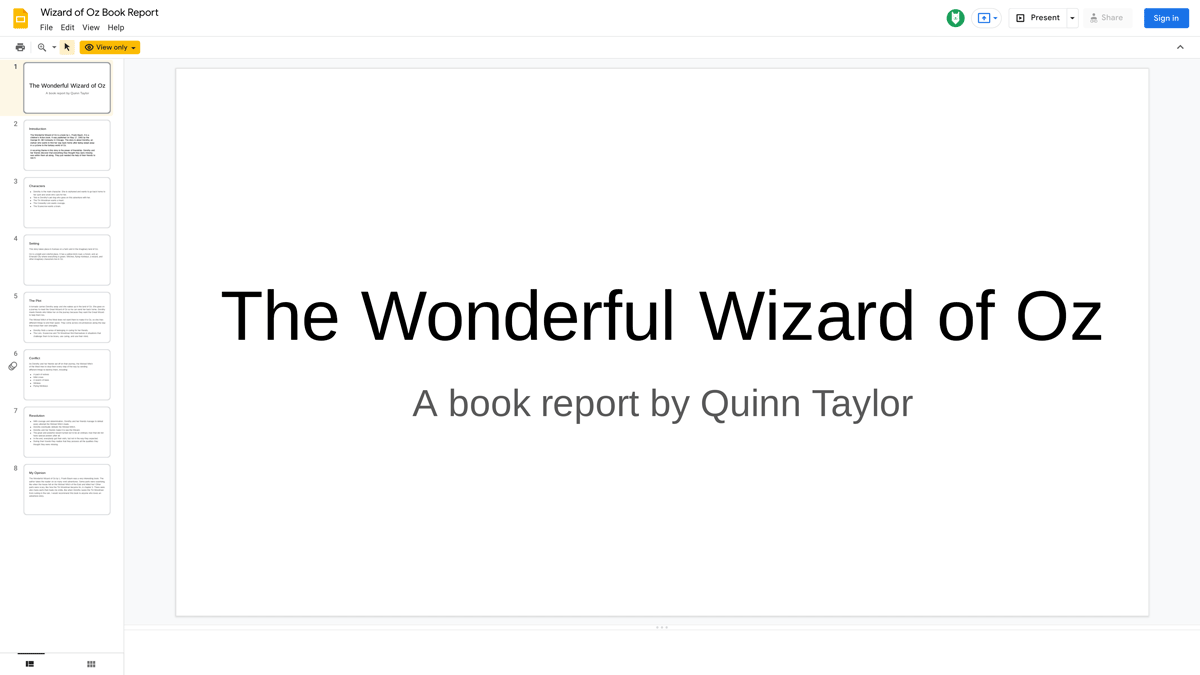
- Teaching Materials
Time to complete
access_time 45—90 minutes
Digital tools
- Communication
- Creating a report
- Digital publishing
- Effective communication
- Identify relevant data
- Presentation formatting
- Researching a topic
- Sharing research
- Slide design
- Writing strategies

- Number of visits 38
- Number of saves 1
Video Book Report Lesson Plan
- Report this resource
Description

Utah Core English Language Arts (2011)
Learning Domain: Reading for Literature
Standard: Determine a theme or central idea of a text and analyze its development over the course of the text, including its relationship to the characters, setting, and plot; provide an objective summary of the text.
Degree of Alignment: Not Rated (0 users)
Evaluations
No evaluations yet.
- Lesson Plan
- Video Book Report
- photography
Version History
Review Criteria
Ready to get started?
- Education , Inspiration
15 creative video project ideas for students (and their teachers)

Fall is here. The leaves are starting to change color and teachers everywhere are asking the same question: How do I come up with video project ideas for my students?
Video has been a staple learning tool for decades. But having students create, design, and edit video projects themselves is becoming a much more common classroom activity. Video projects are a great way to help students of all ages actively engage with subject matter and learn from one another.
Online apps like Biteable make it easy for students to turn video ideas for school into a reality. Templates and easy-to-use editing tools keep the process simple and offer plenty of inspiration for student video projects.
To help teachers and students alike leverage video as an educational tool , we’ve gathered our favorite creative video project ideas for students. Each idea comes with a ready-to-edit video template so you and your students can get started right away.
Create videos that drive action
Activate your audience with impactful, on-brand videos. Create them simply and collaboratively with Biteable.
Elementary student video project ideas
It can be tricky to keep young students interested and engaged all day long. Creating videos gives elementary students a fun, creative way to learn about anything. And student-created videos are an amazing classroom learning supplement. If a video is produced by their peers, interest will skyrocket.
1. Create a book trailer
Instead of a traditional book report, have students design a movie-style trailer that drums up excitement about a novel or a non-fiction book. Creating a book trailer gives students the opportunity to think creatively, share a story with their classmates, and reinforce their learning in a new way.
2. Give a video tour
To supplement social studies curriculum, students can create a video showing off a significant location or their favorite part of the school. If you have a field trip planned, ask students to share their experience by recording videos throughout the day and adding voice over narration.
A video tour of the school is also a great way to share the campus with new students and visitors. As a way to pass the torch before they leave for middle school, how about asking your fifth graders to collaborate on an orientation video for incoming kindergarteners?
3. Celebrate the holidays
There’s always something to celebrate, no matter what time of year it is. Have students film letters to Santa, make video Valentines for parents or grandparents, or make short educational videos about lesser known holidays. Students can even create simple, digital thank-you notes for classroom visitors or parent volunteers.
4. Recreate a moment in history
Learning about historical people and events? Have your students research and recreate major moments in history, like the story of Rosa Parks or the Oregon Trail.
Videos help students visualize and remember these important moments. It also gives students the opportunity to experiment with digital storytelling. And students will be challenged to bring each scene to life accurately.
5. Try stop-motion video
Video learning isn’t limited to literary or historical topics. Encourage students to use stop-motion or create their own slides to explain science experiments or other STEM projects. With the right footage, like Biteable’s extensive collection of clay animation footage, students won’t even need to build stop motion models. They can just focus on the presentation and storytelling in their video.
Video project ideas for middle and high school students
Video projects for high schoolers can be a little more advanced, as students should be practicing editing and narrative skills in addition to learning about new topics.
6. Create a news channel
To supplement learning in a current events class, have your students film a news broadcast covering both local and international events.
Ask students to take on certain roles in the newsroom: anchor, sports reporter, weather reporter, or entertainment correspondent. Doing a news segment helps everyone get involved and promotes teamwork.
7. Start a portfolio
Many high school students are thinking about college applications. Give them the chance to jumpstart their applications with a portfolio video project and showcase what makes them unique.
Art students can show off their best work and design skills. Students applying to traditional schools can answer an application question or create a video showcasing their community service and extracurriculars.
8. Promote a good cause
Rather than writing a traditional essay or report, have students create a video advocating for a cause that’s important to them. This helps students build their identity and develop persuasive skills. And students can share their promotional video with everyone, not just their teacher and classmates.
9. Questions for your future self
Think ahead with a video full of inspiring questions. This project is great for incoming freshmen. At the beginning of the year, have students create videos with questions for their future self or with goals for their life and career. At graduation, send the videos back to them. It’s a fun, positive way to celebrate their success throughout high school.
Higher ed video project ideas
Higher education might not seem like the place for student-made videos. But in the real world, businesses use video for all sorts of things. Video projects build plenty of resume-worthy skills that college students can take with them to the workforce.
10. Create a university promotion video
It’s easy to forget that colleges and universities are businesses, too. And they need help with promotion. A solid college or university promotion video could open opportunities for internships or college employment. Promoting something that they’re already familiar with is a great way for students to build video persuasion skills.
11. Record and edit interviews
Being able to conduct a good interview and edit it in a way that’s appropriate for the purpose of the interview is a valuable skill in multiple industries. And interviewing experts in the field is appropriate for just about any class.
12. Make a video self-assessment
Grades are important. But being able to self-assess is also an incredibly valuable way for students to incrementally improve at any skill.
Making video self-assessments gives students a more active role in the grading process and offers them a creative way to highlight the work they’ve put into a course. It also gives them a chance to make an argument for the grade they feel they deserve — a skill that easily correlates to performance reviews in their future workplace.
13. Film a job interview guide
For most people, the interview is the most nerve-wracking part of getting a job. Practicing interview questions is a great way to prepare. But most students don’t know how to prepare for a job interview.
Creating a job interview how-to guide is a perfect way for students to learn how to prepare for a job interview and help other students prepare at the same time.
14. Create a video presentation based on a written assignment
Written assignments are the backbone of a university education (in most disciplines, at least). However, the audience for most written assignments is limited to the professor and assistants. Creating presentation videos for their assignments gives students the opportunity to share their hard work with their fellow students, while also learning valuable video editing skills.
15. Build a video resume
For most students, the job search starts even before graduation. A video resume helps students highlight the skills they acquired and the experience they gained during college. And, given the global workforce, a video resume is a great supplement to a paper resume, especially when applying for remote or distant positions where an in-person interview may not be an option.
Take your video project from idea to reality with Biteable
Ready to get started making an education video project ?
Biteable has a huge library of video templates that help students get going fast rather than struggling to start from a blank screen. Drag-and-drop editing and easy to use tools let students focus on what’s important: the project assignment and delivering a thoughtful message.
Make stunning videos with ease.
Take the struggle out of team communication.
Try Biteable now.
- No credit card required
- No complicated design decisions
- No experience necessary
- PRO Courses Guides New Tech Help Pro Expert Videos About wikiHow Pro Upgrade Sign In
- EDIT Edit this Article
- EXPLORE Tech Help Pro About Us Random Article Quizzes Request a New Article Community Dashboard This Or That Game Popular Categories Arts and Entertainment Artwork Books Movies Computers and Electronics Computers Phone Skills Technology Hacks Health Men's Health Mental Health Women's Health Relationships Dating Love Relationship Issues Hobbies and Crafts Crafts Drawing Games Education & Communication Communication Skills Personal Development Studying Personal Care and Style Fashion Hair Care Personal Hygiene Youth Personal Care School Stuff Dating All Categories Arts and Entertainment Finance and Business Home and Garden Relationship Quizzes Cars & Other Vehicles Food and Entertaining Personal Care and Style Sports and Fitness Computers and Electronics Health Pets and Animals Travel Education & Communication Hobbies and Crafts Philosophy and Religion Work World Family Life Holidays and Traditions Relationships Youth
- Browse Articles
- Learn Something New
- Quizzes Hot
- This Or That Game New
- Train Your Brain
- Explore More
- Support wikiHow
- About wikiHow
- Log in / Sign up
- Arts and Entertainment
A Beginner's Guide to Writing a Book Report (with Examples)
Last Updated: March 13, 2024 Fact Checked
Researching Your Book Report
Outlining your book report, writing your book report, reviewing and revising your book report, sample book reports & summaries, expert q&a.
This article was co-authored by Jake Adams and by wikiHow staff writer, Raven Minyard, BA . Jake Adams is an academic tutor and the owner of Simplifi EDU, a Santa Monica, California based online tutoring business offering learning resources and online tutors for academic subjects K-College, SAT & ACT prep, and college admissions applications. With over 14 years of professional tutoring experience, Jake is dedicated to providing his clients the very best online tutoring experience and access to a network of excellent undergraduate and graduate-level tutors from top colleges all over the nation. Jake holds a BS in International Business and Marketing from Pepperdine University. There are 9 references cited in this article, which can be found at the bottom of the page. This article has been fact-checked, ensuring the accuracy of any cited facts and confirming the authority of its sources. This article has been viewed 1,413,816 times.
A book report is a short essay that summarizes and analyzes a work of fiction or nonfiction. Writing a book report may not seem fun at first, but it gives you a great chance to fully understand a work and its author. In this article, we’ll teach you everything you need to know about how to write a book report, from choosing a book and outlining to drafting and editing your final paper.
Things You Should Know
- Read the entire book and take notes on important themes, characters, and events. Use your notes to create an outline with evidence that supports your analysis.
- Include the title and author in your intro, then summarize the plot, main characters, and setting of the book.
- Analyze the author’s writing style, as well as the main themes and arguments of the book. Include quotes and examples to support your statements.

- For example, find out if your teacher wants you to include citations, such as page numbers from the book, in your report.
- Ask your teacher how much of your paper to devote to summary versus analysis. Most book reports are direct summaries with objective analysis rather than your personal opinions. In contrast, a book review or commentary is more opinion-driven.
- Some popular books for book reports include To Kill a Mockingbird by Harper Lee, Animal Farm by George Orwell, and The Hunger Games by Suzanne Collins. Choose a book at your grade level.

- Author: Who wrote the book? Do you know any other works by this author?
- Genre: Is the book fiction or nonfiction? If it’s fiction, is it historical, fantasy, horror, etc.? If it’s nonfiction, is it a biography, memoir, science, etc.?
- Audience: Who would find this book appealing? Is it intended for a specific age range or gender? Do you typically enjoy books like this?
- Title: Does the title catch your interest? Does it fit well with the book’s content?
- Book Cover/Illustrations: What does the book cover convey and does it accurately represent the book? How do you feel when you look at it? If the book has illustrations, what are they and do they hold your interest?

- Take breaks while reading to keep your attention sharp. Try to find a pace that is comfortable for you. If you get distracted after 15 minutes, read in 15-minute intervals. If you can go an hour, read for an hour at a time.
- Give yourself enough time to read the entire book. It’s very difficult to write a book report if you’ve just skimmed over everything. Don’t procrastinate!
- Don’t trust online book summaries. You can’t guarantee that they are accurate or true to the text.

- For example, look for a sentence that clearly describes a main setting in the book, such as “The castle was gloomy and made out of large black stones.”

- Introduction: Introduce the title, author, and publication information. Include a brief overview of the book’s genre and main theme, and state your purpose for writing the report.
- Summary: Concisely summarize the plot or central idea, highlighting main events, characters, and conflicts. Focus on important aspects while avoiding spoilers.
- Analysis and Evaluation: Evaluate the author’s writing style and use of literary devices, like foreshadowing, metaphors, imagery, etc. Discuss the strengths and weaknesses of the book and use quotes and examples from the text.
- Themes and Messages: Identify the book’s main themes or messages and how they develop through the course of the book. Provide specific quotes and examples.
- Character Analysis: Analyze the main characters in the book, their development, and their relationships. Explain their motivations, personalities, and significance to the story. Provide examples and quotes to support your analysis.
- Personal Reflection: Depending on your teacher’s instructions, you might share your personal opinions and discuss what you liked and disliked about the book. Reflect on how the book relates to broader themes or issues.
- Conclusion: Summarize your main points and conclude with your final thoughts or reflections on the book.
- Bibliography: If required, include a works cited page or bibliography listing all the sources you used to write your book report.
- Outlining takes time, but it saves you more time once you reach the editing stage.
- Some people prefer to outline with pen and paper, while others just type up a list on the computer. Choose the method that works best for you.

- Be careful not to overuse quotes. If it seems like every other line is a quote, try to dial back. Aim to include a maximum of one quotation per paragraph. Quotes and examples should still take a backseat to your summary.

- For example, you’ll likely need to focus primarily on discussing the most important characters or the characters that appear most frequently in the text.
- When you are finished with your outline, go back through it to see if it makes sense. If the paragraphs don’t flow into one another, move them around or add/delete new ones until they do.
- Also, check to see if your outline covers all of the major elements of the book, such as the plot, characters, and setting.

- For example, a sentence summary might state, “This book is about the main character’s journey to Africa and what she learns on her travels.”
- Don’t take up too much space with your introduction. In general, an introduction should be 3-6 sentences long, though in rare cases, they may be longer or shorter.

- Use vivid language when you can and include plenty of details. For example, you might write, “The farm was surrounded by rolling hills.”

- For instance, if the main character moves to Africa, you might describe what happens before the move, how the move goes, and how they settle in once they arrive.

- For example, you might write that the main character is “a middle-aged woman who enjoys the finer things in life, such as designer clothes.” Then, connect this description to the plot summary by describing how her views change after her travels, if they do.
- Expect to introduce the characters in the same sentences and paragraphs as the plot introduction.

- You might write, “The author argues that travel gives you a new perspective. That is why her main characters all seem happier and more grounded after visiting new places.”
- For fiction, determine if the author is using the story to pass along a certain moral or lesson. For example, a book about an underdog athlete could encourage readers to take chances to pursue their dreams.

- For example, an author who uses lots of slang terms is probably going for a hip, approachable style.

- Some teachers require, or strongly suggest, that you include the author’s name and the book title in your concluding paragraph.
- When writing a conclusion , don’t introduce any new thoughts. Any important points should be made in your body paragraphs. Save the space for your recap.

- Before you submit your paper, make sure that you’ve spelled the author’s name and any character names correctly.
- Don’t trust your computer’s spell check to catch all the errors for you. Spell check can be helpful, but it isn’t perfect and can make mistakes.

- If you’re nervous about asking, try saying something like “It would be great if you could go over my book report and make sure that it reads smoothly.”
- Remember, no one’s first draft is perfect, so don’t get upset if someone suggests you do something differently. They want to help make your report the best it can be, so don’t take constructive criticism personally.

- For example, double-check that you are using the correct font, font size, and margins.
- Once you've finished proofreading, revising, and checking that you've addressed all the requirements, you're ready to submit your book report!

- Even though your book report is your own work, avoid using “I” too much. It can make your writing feel choppy. Thanks Helpful 1 Not Helpful 0
- It might be tempting to watch the movie or read the online notes instead of reading the book. Resist this urge! Your teacher will be able to tell the difference. Thanks Helpful 1 Not Helpful 0
Tips from our Readers
- Calm down and walk around if you get too frustrated while writing. If you write a book report while angry, you're more likely to misspell things!
- Choose a unique book. Harry Potter or Percy Jackson is an absolute no. Everyone chooses those. Try something different!
- Write when anything comes to mind! You don't want to lose your ideas!

- Give yourself plenty of time to write your report. Don’t wait until the last minute or you may feel rushed. Thanks Helpful 2 Not Helpful 0
- Stealing or using another person’s work is considered plagiarism and academic dishonesty. Make sure that the work you submit is all your own. Thanks Helpful 1 Not Helpful 0
You Might Also Like

- ↑ https://www.aresearchguide.com/write-book-report.html
- ↑ Jake Adams. Academic Tutor & Test Prep Specialist. Expert Interview. 24 July 2020.
- ↑ https://grammark.org/how-to-write-a-book-report/
- ↑ https://library.valleycollege.edu/elements_of_book_report.pdf
- ↑ https://takelessons.com/blog/steps-to-writing-a-book-report
- ↑ https://www.infoplease.com/homework-help/homework-center-writing-book-report
- ↑ https://liberalarts.oregonstate.edu/wlf/what-setting
- ↑ https://www.tcc.edu/wp-content/uploads/archive/writing-center-handouts/essay-types-plot-summary.pdf
- ↑ https://www.cornerstone.edu/blog-post/six-steps-to-really-edit-your-paper/
About This Article

To write a book report, start by introducing the author and the name of the book and then briefly summarizing the story. Next, discuss the main themes and point out what you think the author is trying to suggest to the reader. Finally, write about the author’s style of writing, paying particular attention to word choice and the overall tone of the book. For tips on editing and polishing your paper before turning it in, keep reading! Did this summary help you? Yes No
- Send fan mail to authors
Reader Success Stories
Louise Pena
May 17, 2016

Did this article help you?

Ashley Egerage
Nov 13, 2017
Aug 20, 2016
Charlotte Arney
Mar 10, 2023
Nov 16, 2017

Featured Articles

Trending Articles

Watch Articles

- Terms of Use
- Privacy Policy
- Do Not Sell or Share My Info
- Not Selling Info
wikiHow Tech Help Pro:
Level up your tech skills and stay ahead of the curve

We've saved your template
Now login with a desktop and start editing your video
- Video Makers
- Graduation Video
- Wedding Video
- Highlight Video
- Funny Video
- YouTube Looper
- Fitness trainer
- Christmas Video
- Memorial Video
- Facebook Video
- View all makers
- Change Video Speed
- Resize Video
- Online Facebook Slideshow Maker
- Image Sequence to Video
- Make a Photo Video
- Make A Video Online
- Add Sound Effects to Video Online
- Speed up Videos Online
- Add SRT to MP4 Online
- View all tools
- BBC Templates
- YouTube Templates
- Tech Insider Templates
- Tasty Templates
- DIY Templates
- UNILAD Templates
- Typewriting Templates
- Intro Templates
- Timer Templates
- Shopify Templates
- View all templates
- Video Templates
- Non Profit Templates
- E-Commerce Templates
- Fitness Templates
- Lifestyle Templates
- Trending Templates
- Food Templates
- Event Templates
- Fashion Templates
- Teaser Templates
- Corporate Templates
- Privacy Policy
- Terms of Use
- Cookies Policy
- GDPR Compliance
- Help Center
© 2024 Typito.com All Rights Reserved.
- Grades 6-12
- School Leaders
Learn How to Support Stressed and Anxious Students.
42 Creative Book Report Ideas for Students
Inspire your students to share their love of books.

Responding to what you read is an important literacy skill. Reading about other people’s experiences and perspectives helps kids learn about the world. And although students don’t need to dive deeply into every single book they read, occasionally digging into characters, settings, and themes can help them learn to look beyond the prose. Here are 42 creative book report ideas designed to make reading more meaningful.
1. Concrete Found Poem

This clever activity is basically a shape poem made up of words, phrases, and whole sentences found in the books students read. The words come together to create an image that represents something from the story.
2. Graphic Novel
Have students rewrite the book they are reading, or a chapter of their book, as a graphic novel. Set parameters for the assignment such as including six scenes from the story, three characters, details about the setting, etc. And, of course, include detailed illustrations to accompany the story.
3. Book Snaps

Book Snaps are a way for students to visually show how they are reacting to, processing, and/or connecting with a text. First, students snap a picture of a page in the book they are reading. Then, they add comments, images, highlights, and more.
4. Diary Entry
Have your students place themselves in the shoes of one of the characters from their book and write a first-person diary entry of a critical moment from the story. Ask them to choose a moment in the story where the character has plenty of interaction and emotion to share in a diary entry.
5. Character To-Do List

This fun activity is an off-the-beaten-path way to dive deep into character analysis. Get inside the head of the main character in a book and write a to-do list that they might write. Use actual information from the text, but also make inferences into what that character may wish to accomplish.
6. Mint Tin Book Report

There are so many super-creative, open-ended projects you can use mint tins for. This teacher blogger describes the process of creating book reports using them. There’s even a free template for cards that fit inside.
7. Fictional Yearbook Entries
Ask your students to create a yearbook based on the characters and setting in the book. What do they look like? Cut out magazine pictures to give a good visual image for their school picture. What kind of superlative might they get? Best looking? Class clown? What clubs would they be in or lead? Did they win any awards? It should be obvious from their small yearbooks whether your students dug deep into the characters in their books. They may also learn that who we are as individuals is reflected in what we choose to do with our lives.
8. Book Report Cake

This project would be perfect for a book tasting in your classroom! Each student presents their book report in the shape of food. See the sandwich and pizza options above and check out this blog for more delicious ideas.
9. Current Events Comparison
Have students locate three to five current events articles a character in their book might be interested in. After they’ve found the articles, have them explain why the character would find them interesting and how they relate to the book. Learning about how current events affect time, place, and people is critical to helping develop opinions about what we read and experience in life.
10. Sandwich Book Report

Yum! You’ll notice a lot of our creative book report ideas revolve around food. In this oldie but goodie, each layer of this book report sandwich covers a different element of the book—characters, setting, conflict, etc. A fun adaptation of this project is the book report cheeseburger.
11. Book Alphabet
Choose 15 to 20 alphabet books to help give your students examples of how they work around themes. Then ask your students to create their own Book Alphabet based on the book they read. What artifacts, vocabulary words, and names reflect the important parts of the book? After they find a word to represent each letter, have them write one sentence that explains where the word fits in.
12. Peekaboo Book Report

Using cardboard lap books (or small science report boards), students include details about their book’s main characters, plot, setting, conflict, resolution, etc. Then they draw a head and arms on card stock and attach them to the board from behind to make it look like the main character is peeking over the report.
13. T-Shirt Book Report

Another fun and creative idea: Create a wearable book report with a plain white tee. Come up with your own using Sharpie pens and acrylic paint. Get step-by-step directions .
14. Book Jacket
Have students create a new book jacket for their story. Include an attractive illustrated cover, a summary, a short biography of the author, and a few reviews from readers.
15. Watercolor Rainbow Book Report
This is great for biography research projects. Students cut out a photocopied image of their subject and glue it in the middle. Then, they draw lines from the image to the edges of the paper, like rays of sunshine, and fill in each section with information about the person. As a book report template, the center image could be a copy of the book cover, and each section expands on key information such as character names, theme(s), conflict, resolution, etc.
16. Act the Part
Have students dress up as their favorite character from the book and present an oral book report. If their favorite character is not the main character, retell the story from their point of view.
17. Pizza Box Book Report

If you’re looking for creative book report ideas that use upcycled materials, try this one using a pizza box. It works well for both nonfiction and fiction book reports. The top lid provides a picture of the book cover. Each wedge of the pizza pie tells part of the story.
18. Bookmark
Have students create a custom illustrated bookmark that includes drawings and words from either their favorite chapter or the entire book.
19. Book Reports in a Bag

Looking for book report ideas that really encourage creative thinking? With book reports in a bag, students read a book and write a summary. Then, they decorate a paper grocery bag with a scene from the book, place five items that represent something from the book inside the bag, and present the bag to the class.
20. Reading Lists for Characters
Ask your students to think about a character in their book. What kinds of books might that character like to read? Take them to the library to choose five books the character might have on their to-be-read list. Have them list the books and explain what each book might mean to the character. Post the to-be-read lists for others to see and choose from—there’s nothing like trying out a book character’s style when developing your own identity.
21. File Folder Book Report

Also called a lap book, this easy-to-make book report hits on all the major elements of a book study and gives students a chance to show what they know in a colorful way.
22. Collage
Create a collage using pictures and words that represent different parts of the book. Use old magazines or print pictures from the Internet.
23. Book Report Triorama

Who doesn’t love a multidimensional book report? This image shows a 3D model, but Elisha Ann provides a lesson to show students how to glue four triangles together to make a 4D model.
24. Timeline
Have students create a timeline of the main events from their book. Be sure to include character names and details for each event. Use 8 x 11 sheets of paper taped together or a long portion of bulletin board paper.
25. Clothes Hanger Book Report Mobile

This creative project doesn’t require a fancy or expensive supply list. Students just need an ordinary clothes hanger, strings, and paper. The body of the hanger is used to identify the book, and the cards on the strings dangling below are filled with key elements of the book, like characters, setting, and a summary.
26. Public Service Announcement
If a student has read a book about a cause that affects people, animals, or the environment, teach them about public service announcements . Once they understand what a PSA is, have them research the issue or cause that stood out in the book. Then give them a template for a storyboard so they can create their own PSA. Some students might want to take it a step further and create a video based on their storyboard. Consider sharing their storyboard or video with an organization that supports the cause or issue.
27. Dodecahedron Book Report

Creative book report ideas think outside the box. In this case, it’s a ball! SO much information can be covered on the 12 panels , and it allows students to take a deep dive in a creative way.
28. Character Cards
Make trading cards (like baseball cards) for a few characters from the book. On the front side, draw the character. On the back side, make a list of their character traits and include a quote or two.
29. Book Report Booklets

This clever book report is made from ordinary paper bags. Stack the paper bags on top of each other, fold them in half, and staple the closed-off ends of the bags together. Students can write, draw, and decorate on the paper bag pages. They can also record information on writing or drawing paper and glue the paper onto the pages. The open ends of the bags can be used as pockets to insert photos, cut-outs, postcards, or other flat items that help them tell their story.
30. Letter to the Author
Write a letter to the author of the book. Tell them three things you really liked about the story. Ask three questions about the plot, characters, or anything else you’re curious about.
31. Book Report Charm Bracelet

What a “charming” way to write a book report! Each illustrated bracelet charm captures a character, an event in the plot, setting, or other detail.
32. Fact Sheet
Have students create a list of 10 facts that they learned from reading the book. Have them write the facts in complete sentences, and be sure that each fact is something that they didn’t know before they read the book.
33. Cereal Box TV Book Report

This book report project is a low-tech version of a television made from a cereal box and two paper towel rolls. Students create the viewing screen cut-out at the top, then insert a scroll of paper with writing and illustrations inside the box. When the cardboard roll is rotated, the story unfolds.
34. Be a Character Therapist
Therapists work to uncover their clients’ fears based on their words and actions. When we read books, we must learn to use a character’s actions and dialogue to infer their fears. Many plots revolve around a character’s fear and the work it takes to overcome that fear. Ask students to identify a character’s fear and find 8 to 10 scenes that prove this fear exists. Then have them write about ways the character overcame the fear (or didn’t) in the story. What might the character have done differently?
35. Mind Maps
Mind maps can be a great way to synthesize what students have learned from reading a book. Plus, there are so many ways to approach them. Begin by writing a central idea in the middle of the page. For example, general information, characters, plot, etc. Then branch out from the center with ideas, thoughts, and connections to material from the book.
36. Foldables

From Rainbows Within Reach , this clever idea would be a great introduction to writing book reports. Adapt the flap categories for students at different levels. Adjust the number of categories (or flaps) per the needs of your students.
37. Board games
This is a great project if you want your students to develop a little more insight into what they’re reading. Have them think about the elements of their favorite board games and how they can be adapted to fit this assignment. For more, here are step-by-step directions .
38. Comic strips

If you’re looking for creative book report ideas for students who like graphic novels, try comic strips. Include an illustrated cover with the title and author. The pages of the book should retell the story using dialogue and descriptions of the setting and characters. Of course, no comic book would be complete without copious illustrations and thought bubbles.
39. Timeline
Create a timeline using a long roll of butcher paper, a poster board, or index cards taped together. For each event on the timeline, write a brief description of what happens. Add pictures, clip art, word art, and symbols to make the timeline more lively and colorful.
40. Cereal Box
Recycle a cereal box and create a book report Wheaties-style. Decorate all sides of the box with information about the book’s characters, setting, plot, summary, etc.
41. Wanted Poster

Make a “wanted” poster for one of the book’s main characters. Indicate whether they are wanted dead or alive. Include a picture of the character and a description of what the character is “wanted” for, three examples of the character showing this trait, and a detailed account of where the character was last seen.
42. Movie Version
If the book your students have read has been made into a movie, have them write a report about how the versions are alike and different. If the book has not been made into a movie, have them write a report telling how they would make it into a movie, using specific details from the book.
What creative book report ideas did we miss? Come share in our We Are Teachers HELPLINE group on Facebook.
Plus, check out the most popular kids’ books in every grade..

You Might Also Like

Expand Your Readers’ Palates With a Book Tasting
A perfect way for kids to nibble on a book. Continue Reading
Copyright © 2024. All rights reserved. 5335 Gate Parkway, Jacksonville, FL 32256
video book report
All Formats
Resource types, all resource types.
- Rating Count
- Price (Ascending)
- Price (Descending)
- Most Recent
Video book report
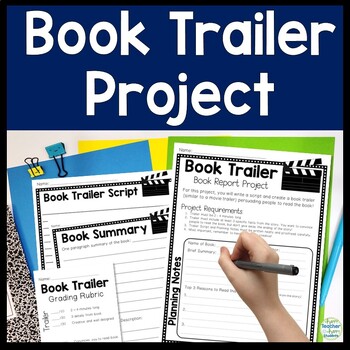
Book Trailer Book Report | Book Trailer Project | Make Video or Skit Trailer
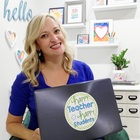
Video Book Review/ Book Report Project for Teens - Fiction
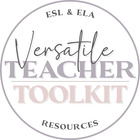
Author or Character Podcast or Video Interview Book Report Project

- Google Drive™ folder
![video book report Preview of Slide Paper Video [Book Report]](https://ecdn.teacherspayteachers.com/thumbitem/Slide-Paper-Video-Book-Report-2777982-1657611284/original-2777982-1.jpg)
Slide Paper Video [ Book Report ]

Book Report Template, Distance Learning Video Book Report
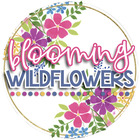
CANVA Product Preview Video TEMPLATE | LIBRARY BOOK REPORT Design
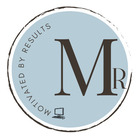
Martin Luther King Jr. Evaluation Book Report Worksheet Plus Video

- Supporting Information
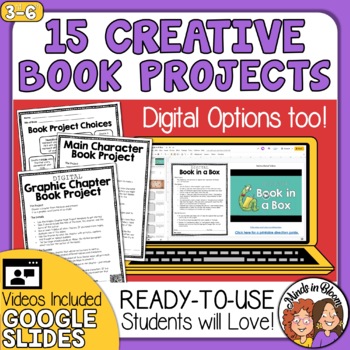
Book Report Projects for Any Book Student Instructions Rubrics & Digital Options

- Google Apps™
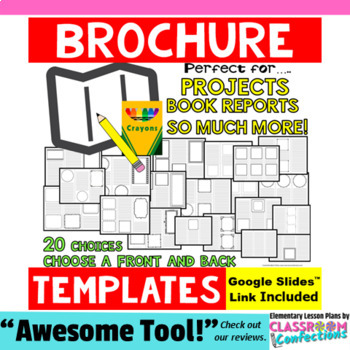
Brochure Templates | Book Report Project | Research Template Writing Activity

Novel Study Choice Board: 12 Creative Project Prompts better than a Book Report

Catholic Saint Report Trifold Brochure
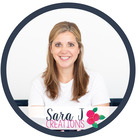
Biography Report & QR Codes for Biography Research Report BUNDLE Websites Videos

Nonfiction Book Report Print & Google Classroom™

Biography Project | Who Was Biographies Book Report | Informational Writing
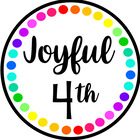
Novel Study/ Book Report "Exploding Box" Project (For Any Book )

Where the Wild Things Are | Picture Book Study | Picture Book Activities
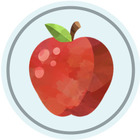
- Easel Activity
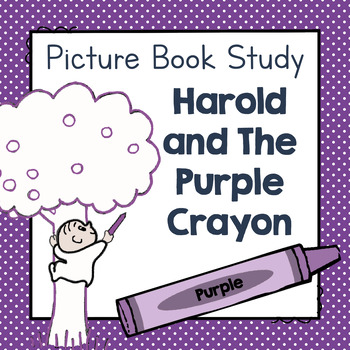
Harold and the Purple Crayon | Picture Book Study | Picture Book Activities

Ferdinand | Picture Book Study | Picture Book Activities | No Prep

The Rainbow Fish | Picture Book Study | Picture Book Activities | No Prep

The Biggest Valentine Ever | Picture Book Study | Picture Book Activities
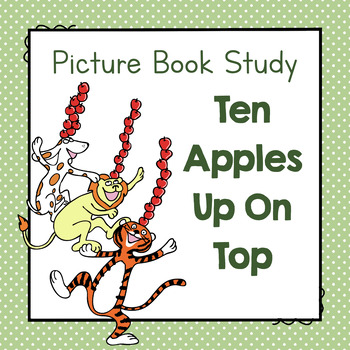
Ten Apples Up On Top | Picture Book Study | Picture Book Activities | No Prep
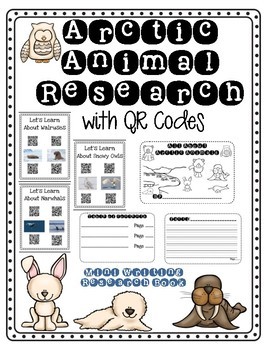
Arctic Animal QR Code Research with Nonfiction Writing Book

- Internet Activities
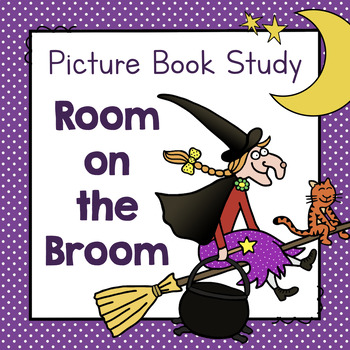
Room on the Broom | Picture Book Study | Picture Book Activities | No Prep
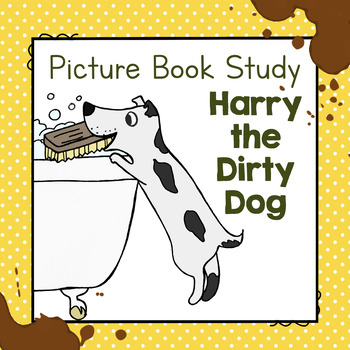
Harry the Dirty Dog | Picture Book Study | Picture Book Activities | No Prep
- We're hiring
- Help & FAQ
- Privacy policy
- Student privacy
- Terms of service
- Tell us what you think
Purdue Online Writing Lab Purdue OWL® College of Liberal Arts
Writing a Book Report

Welcome to the Purdue OWL
This page is brought to you by the OWL at Purdue University. When printing this page, you must include the entire legal notice.
Copyright ©1995-2018 by The Writing Lab & The OWL at Purdue and Purdue University. All rights reserved. This material may not be published, reproduced, broadcast, rewritten, or redistributed without permission. Use of this site constitutes acceptance of our terms and conditions of fair use.
Book reports are informative reports that discuss a book from an objective stance. They are similar to book reviews but focus more on a summary of the work than an evaluation of it. Book reports commonly describe what happens in a work; their focus is primarily on giving an account of the major plot, characters, thesis, and/or main idea of the work. Most often, book reports are a K-12 assignment and range from 250 to 500 words.
Book reviews are most often a college assignment, but they also appear in many professional works: magazines, newspapers, and academic journals. If you are looking to write a book review instead of a book report, please see the OWL resource, Writing a Book Review .
Before You Read
Before you begin to read, consider what types of things you will need to write your book report. First, you will need to get some basic information from the book:
- Publisher location, name of publisher, year published
- Number of Pages
You can either begin your report with some sort of citation, or you can incorporate some of these items into the report itself.
Next, try to answer the following questions to get you started thinking about the book:
- Author: Who is the author? Have you read any other works by this author?
- Genre: What type of book is this: fiction, nonfiction, biography, etc.? What types of people would like to read this kind of book? Do you typically read these kinds of books? Do you like them?
- Title: What does the title do for you? Does it spark your interest? Does it fit well with the text of the book?
- Pictures/Book Jacket/Cover/Printing: What does the book jacket or book cover say? Is it accurate? Were you excited to read this book because of it? Are there pictures? What kinds are there? Are they interesting?
As You Read
While reading a work of fiction, keep track of the major characters. You can also do the same with biographies. When reading nonfiction works, however, look for the main ideas and be ready to talk about them.
- Characters: Who are the main characters? What happens to them? Did you like them? Were there good and bad characters?
- Main Ideas: What is the main idea of the book? What happens? What did you learn that you did not know before?
- Quotes: What parts did you like best? Are there parts that you could quote to make your report more enjoyable?
When You Are Ready to Write
Announce the book and author. Then, summarize what you have learned from the book. Explain what happens in the book, and discuss the elements you liked, did not like, would have changed, or if you would recommend this book to others and why. Consider the following items as well:
- Principles/characters: What elements did you like best? Which characters did you like best and why? How does the author unfold the story or the main idea of the book?
- Organize: Make sure that most of your paper summarizes the work. Then you may analyze the characters or themes of the work.
- Your Evaluation: Choose one or a few points to discuss about the book. What worked well for you? How does this work compare with others by the same author or other books in the same genre? What major themes, motifs, or terms does the book introduce, and how effective are they? Did the book appeal to you on an emotional or logical way?
- Recommend: Would you recommend this book to others? Why? What would you tell them before they read it? What would you talk about after you read it?
Revising/Final Copy
Do a quick double check of your paper:
- Double-check the spelling of the author name(s), character names, special terms, and publisher.
- Check the punctuation and grammar slowly.
- Make sure you provide enough summary so that your reader or instructor can tell you read the book.
- Consider adding some interesting quotes from the reading.
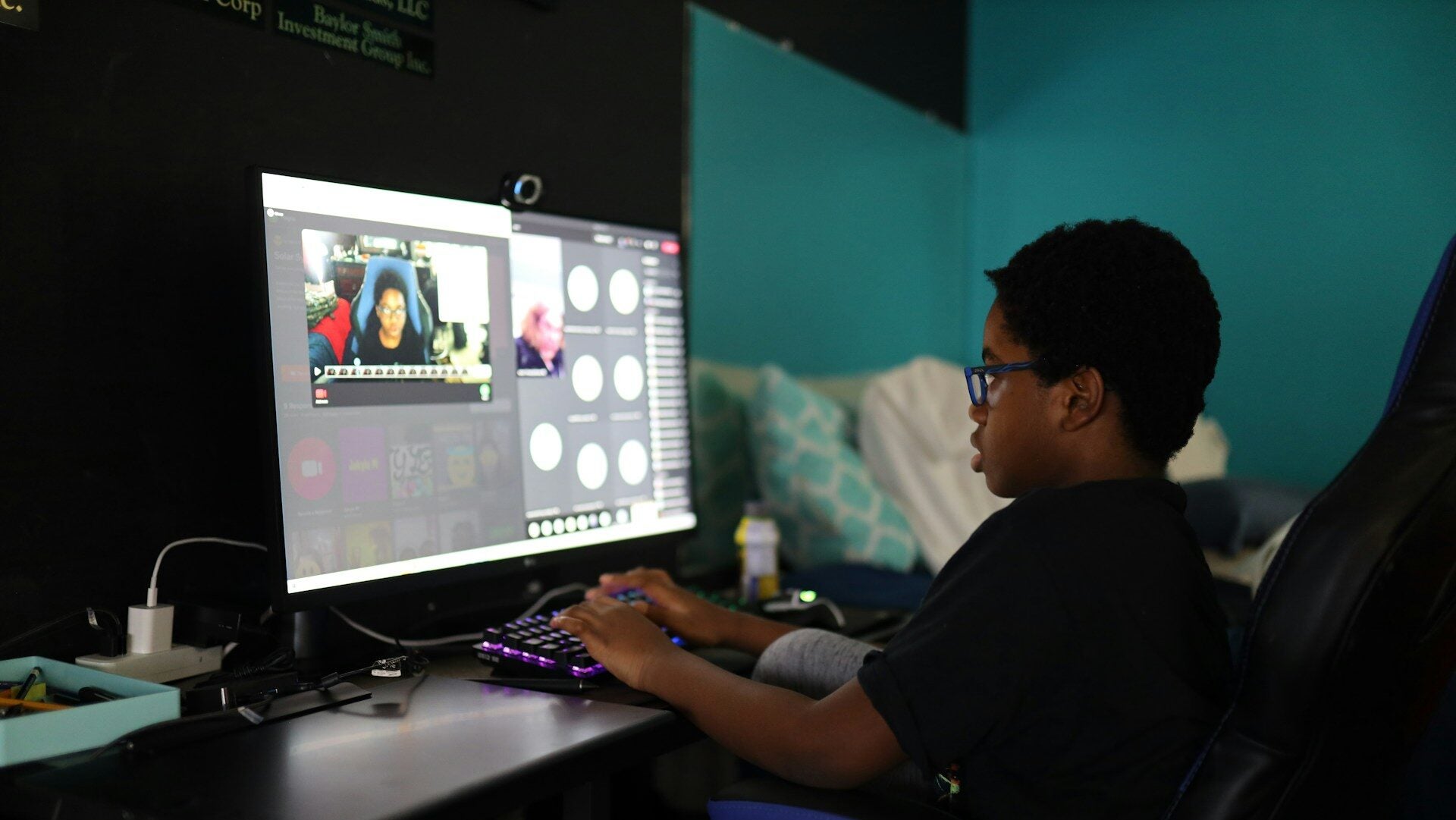
For Kids, How Much Screen Time Is Too Much? Why That’s the Wrong Question to Ask
April 25, 2024
Parents worried about screen time — the cumulative chunk of the day that kids spend watching television, using a smartphone or playing video games — is nothing new. For decades, child psychologists, parents and members of the media have engaged in respective research, hand-wringing and breathless headline-writing decrying technology’s deleterious effects on child development.
In a new book, Early Childhood and Digital Media , developmental psychologist Rachel Barr wants everyone involved to move past this outdated paradigm. Barr, in collaboration with colleagues Heather Kirkorian , Sarah Coyne and Jenny Radesky , is offering the research community a new framework for understanding and measuring the impact of technology on early childhood development.
“Researchers have focused almost exclusively on screen time and simplistic recommendations about its use which does not capture the complexity of our current digital landscape,” said Barr. “Put simply, not all media are not created equal. There are multiple different motivations for use and capturing this complexity would provide families with more precise guidance about the pros and cons of media use.”
Moving Past the Chunk of Time
More so than at any point in the past, technology is embedded into human life and, subsequently, the lives of young children under five years of age. The advent of smartphones and wireless connectivity supercharged a trend that began with radio and television.

Prof. Rachel Barr on Copley Lawn.
“Two decades ago, a television might be on in the background of a family home, but it stayed there,” explained Barr. “Today, however, smart devices travel everywhere with families — they’re at the front and center.”
The ‘chunk of time’ model, which measures media use totaling how much time in front of a screen someone spends in a day and presenting it as the end-all data point is reflective of this earlier technology paradigm. It’s a mode of thinking that has outstayed its utility because the chunk of time doesn’t tell researchers, or parents, about the myriad of factors that determine whether or not digital media use is helping, or hindering, childhood development.
To move past the chunk of time, Barr and her colleagues have introduced the Dynamic, Relational, Ecological Approach to Media Effects Research, or the DREAMER framework. Through this framework, the team hopes to better capture the nuances associated with the vastly varied types of media available to children.
“We want to think about how media is being used in the house and set up a research agenda that would allow us to move beyond ‘is too much media good or bad’ to understand how families are using media and what types of media lead to good and bad outcomes,” said Barr.
There are a slew of variables on which the team is focused, including whether or not digital media is accessed in a silo or collaboratively. Joint media engagement, when parents and children don’t just view, but actively engage with media together, can boost social bonds and educational outcomes.
“A parent and a child may watch an educational program on the television together,” said Barr. “After the program ends, it may spur discussion about the content and a trip outside to play the same game that was in the show or extend upon its content.”
This type of active, engaged media use is vastly different from technology interference, or technoference, which can create barriers in social relationships. Think about picking up a phone in the middle of a conversation to check an email. A parent may cut off their child, introducing a physical and intellectual barrier, and in the process showcase isolating, antisocial technology use.
The Long Shadow of the Pandemic
For Barr, virtual, at-home schooling caused by the pandemic represented an inflection point, showcasing the vast differences in access to technology and how those differences affect childhood educational and social outcomes.
“Some kids went home and used Zoom for school in their own room, on their own device and with stable internet,” said Barr. “Other kids went to a McDonald’s to use a shared device on public wifi so that they could try and keep up.”
The tale of two students illustrates the diversity of experience that Barr and her colleagues hope to capture in the DREAMER framework. In Early Childhood and Digital Media , Barr and her colleagues offer the Comprehensive Assessment of Family Media Exposure (CAFE) toolkit to measure the dynamic range of media use captured by the DREAMER model. So far, the toolkit has been used to conduct research in a dozen countries around the world.
During the pandemic, technology use also led to a range of benefits and drawbacks. In some cases, families and friends were able to connect, engendering positive feelings of community and solidarity. In other cases, many individuals reported becoming sucked into the digital world, which led to increased feelings of isolation and even behavioral and social problems.
Already, Barr has cataloged some of the impacts of the pandemic’s virtual world on children and families. The Georgetown Early Learning Projec t, an on-campus lab founded and led by Barr, documented video chats between grandchildren and grandparents having tremendous positive effects on both parties.
“It is hard for parents to navigate the digital world to harness the power of technology and reduce possible harms,” said Barr. “The DREAMER framework aims to provide a road map for researchers and policymakers to create safe digital spaces for children growing up in the digital world.”
Related Stories

New Report Outlines Best Practices for Parents and Educators in the Digital Age
A new research review from developmental psychologist Rachel Barr provides recommendations for how parents and educators can reap the benefits of digital media while mitigating many potential downsides.
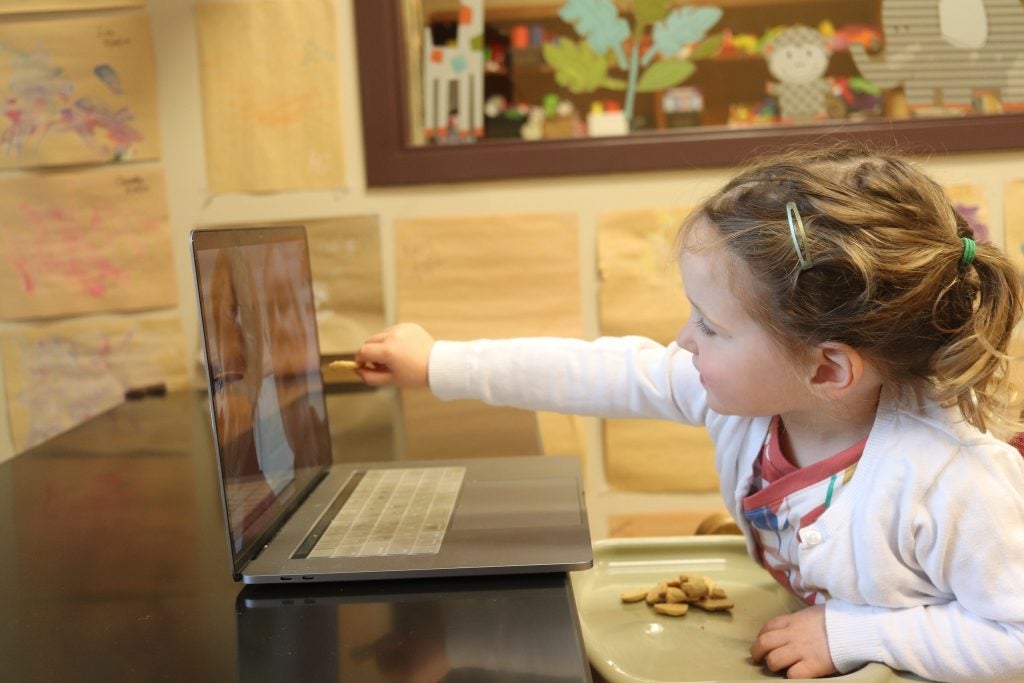
Study by Professor Finds Video Chat Helps Grandparents Maintain Relationships with Grandchildren, Diminishes Feelings of Isolation
A study found that video chat helped grandparents overcome social isolation during the pandemic as well as maintain a vital connection with their young grandchildren.
Recommended
Possible ufo over nyc baffles passenger flying into laguardia.
- View Author Archive
- Get author RSS feed
Thanks for contacting us. We've received your submission.
An airplane passenger took flying saucer speculation to new heights when she spotted a possible UFO soaring above the Big Apple — baffling experts and sending federal aviation officials on a fact-finding mission Thursday.
Michelle Reyes was on a commercial airline flight above LaGuardia Airport on March 25 when she captured video footage of a mysterious “flying cylinder” out of her plane window, she said on Facebook.
“The first thing I did was email the FAA to let them know what I saw,” she told NewsNation Wednesday.
“Maybe it was a safety hazard, but unfortunately I haven’t heard back from them, they didn’t acknowledge my email.”

She said another person on the flight saw the out-of-this-world object and was stunned.
“It’s a little nerve-wracking that someone else saw what I saw,” she said.
Thomas Wertman, the state director of the Mutual UFO Network in Ohio, reviewed the footage for The Post and said the dark object was traveling at roughly 2,500 feet and was “relatively close” to the plane as it prepared for landing.
The object’s altitude, shape and location — near a major commercial flight path — appears to rule out that it could be a news helicopter, a drone or a military aircraft, Wertman said.
“Drones aren’t supposed to fly at that altitude, at least legally,” he said. “If it were something related to [military] defense or law enforcement, you normally wouldn’t see it so close to a major flight lane.”
“That could be a potential hazard,” said Wertman, who has spent years studying the skies for evidence of interplanetary visitors.
The unusual round shape of the object struck him as “intriguing” because it debunks the theory that it was a second plane filmed at an odd angle.
“It does not appear to be a commercial aircraft because I don’t see features like wings or a tail,” he said.
The plane Reyes was aboard was roughly 15 minutes away from LaGuardia Airport likely traveling at 230 mph when the video was shot, he said.

Ultimately, the footage “doesn’t appear to be doctored,” he said.
“It’s a very intriguing image,” he said. “It needs more research.”
There are other theories he can’t rule out, such as high-flying wildlife and weather balloons, without metadata from the footage and other information.
Metadata would help him glean clues about the direction the plane was flying and the exact time of the sighting.
A Federal Aviation Administration official said Thursday the agency has “no reports” from pilots about the mysterious incident.
The flight number and time were not clear Thursday.
Reyes didn’t immediately return a request for comment.
Share this article:
Survivor of the Manchester Arena bombing writes a book about how life has changed
- Manchester Arena attack
- Martin Hibbert
- Friday 26 April 2024 at 5:29pm
Martin Hibbert came into the Granada Reports studio to chat to Elaine Willcox and Gamal Fahnbulleh
A survivor of the Manchester Arena bombing has written a book about how life has changed and what motivates him every day.
22 people died and hundreds more were injured when suicide bomber Salman Abedi detonated a bomb in the foyer of Manchester Arena after an Ariana Grande concert, on 22 May 2017.
Many were children and teenagers.
Martin Hibbert, who was the closest person to the bomber to survive the attack, had bought tickets for his daughter Eve.
He says, almost seven years on, he still feels guilty that she was seriously injured.
Martin was told just five weeks after the attack that he would never walk again and has used his own experience of navigating life in a wheelchair to try to make the world a better place for disabled people.
His book, called Top of the World, charts life after the bombing and his Mount Kilimanjaro climb, for which he's raised almost £1,000,000 for the Spinal Injuries Association.
Martin said: "I wanted to put my own story in my own words."
Speaking about the night of the attack, Martin said he stayed awake until paramedics arrived and at that point he said he did not think he would make it.
He told a security guard to tell his wife Gabby "he loved her".
He suffered PTSD from the impact of the attack on his daughter and admits to feeling 'guilt' he couldn't protect her and has had serious bouts of severe depression.
He described the moment he woke from a coma in hospital a week after the bombing, when he was told he was paralysed from the waist down.
Martin said: "The guilt does creep in every now and again, when I think, I shouldn't have bought those tickets.
"But I suppose it's my mind making sense of that night."
When Martin climbed Kilimanjaro, he took his mum's ashes to scatter at the top of the mountain.
He also took the ashes of one of the bombing victims - Olivia Campbell-Hardy.
The 15-year-old was a talented singer from Bury and had dreamed of travelling the world before she was killed.
He said: "I phoned her mum and there were lots of tears.
"I said it would be an honour if I could take Olivia's ashes. I knew having them both with me that nothing would stop me doing it.
"I knew in those moments where I doubted myself that if I thought about my mum and Olivia, that it would snap me out of it."
Want a quick and expert briefing on the biggest news stories? Listen to our latest podcasts to find out What You Need To Know...

IMAGES
VIDEO
COMMENTS
Spice up the video book report with picture-in-picture effects, transitions, etc. Step 6. Add royalty-free music and sound effects: Click the Music tab and add multiple layers of music and sound effects to evoke the emotions and vibes that fit your book and introduction. Add multiple royalty-free music and sound effects to your book report.
Step by step instructions for students to create a video book report inside of Clips.
After making sure that certain necessities such as a computer, internet connection, and images are available, everything you need to know about creating a video book report using mysimpleshow is below! After signing up with mysimpleshow and having activated your account you choose 'My Videos,' 'Create New Video,' and then 'Write Your ...
Click to open. 7. Book cover. Here, students get to be creative and invent their own book cover (front and back) of the book they just read. Or maybe just a cover for of a piece of text you've read out loud. They can use the whiteboard tools: pencil, type tool, switch colors, add images, etc. Click to open. 8.
Give your students the option of creating an entertaining video version of their book report.Make your own here: http://bit.ly/13nchU4Log in to Animoto and c...
Free Online Book Report Video Maker. Quickly turn your written book reports into interactive a video or slide incorporating images, text captions, and audio with the help of FlexClip's free book report video maker! Choose a template to upload your photos of the book cover, relevant illustrations, or even footage from a movie or drama if ...
Book Report Template - Animated Style. A new twist on a classic assignment. The ability to report on what they read is key to a student's success in school and life. All the more so with video! Use this awesome video book report template to get all your students' senses excited by transforming lame, written book reports into movies! Great for ...
Develop the body: You can follow your outline or a book report template to write the body of your report. Discuss each element (plot, characters, themes, etc.) in separate paragraphs or sections. Conclude your report: Summarize your main points and offer your final thoughts and evaluation of the book. Review and revise: Finally, review and ...
A good book report's introduction hooks the reader with strong opening sentences and provides a preview of where the report is going. "Step-by-Step Outline for a Book Report" ( Classroom ) This article from Classroom furnishes students with a guide to the stages of writing a book report, from writing the rough draft to revising.
This lesson can be used any time throughtout the school year to teach students how to make a video book report through Adobe Express. When it comes to book reports, it's a good option to add variety in format and allow students to use their creativity when recalling events and information learned from the books they've read. 3 45-Minute Class ...
Watch: Introduction to Build a Book Report, a free video lesson from Applied Digital Skills designed to help learners with Google Slides.
A fun way for students to complete a visual book report using Adobe Express video maker. Not only is it more enjoyable than typing up pages of information, but the whole class can enjoy them as well. Students will be required to brainstorm as partners or a group and find creative ways to share the theme, characters, setting, events, and plot from the text through video format.Thumbnail image ...
9. Questions for your future self. Think ahead with a video full of inspiring questions. This project is great for incoming freshmen. At the beginning of the year, have students create videos with questions for their future self or with goals for their life and career. At graduation, send the videos back to them.
Include the title and author in your intro, then summarize the plot, main characters, and setting of the book. Analyze the author's writing style, as well as the main themes and arguments of the book. Include quotes and examples to support your statements. Part 1.
Writing a book report is monotonous. But teachers want us to write a book report to know what we have understood from it. So it is a valuable exercise. If yo...
Create engaging video book reports easily. Ready-made editable video template to make book report videos. Customizable templates- add photos, captions & music.
15. Watercolor Rainbow Book Report. This is great for biography research projects. Students cut out a photocopied image of their subject and glue it in the middle. Then, they draw lines from the image to the edges of the paper, like rays of sunshine, and fill in each section with information about the person.
Try this video book review/book report project assignment for teens that allows more room for creativity and personalized responses to texts. Use this resource as an alternative final assessment idea to the traditional reading comprehension text. You may also use it as a culminating activity at the end of a choice novel/whole-class unit or ...
Book reports commonly describe what happens in a work; their focus is primarily on giving an account of the major plot, characters, thesis, and/or main idea of the work. Most often, book reports are a K-12 assignment and range from 250 to 500 words. Book reviews are most often a college assignment, but they also appear in many professional ...
Hey students! Watch this video to learn how to write a book report.
Cathleen Bate is set to be a major player in My Hero Academia's seventh season, with the franchise sharing a new look at North America's top hero. By Evan Valentine - April 27, 2024 11:59 am EDT ...
"How to Write a Book Report" is a series of videos giving tips for writing better book reports. This channel discusses and reviews books, novels, and short s...
The tale of two students illustrates the diversity of experience that Barr and her colleagues hope to capture in the DREAMER framework. In Early Childhood and Digital Media, Barr and her colleagues offer the Comprehensive Assessment of Family Media Exposure (CAFE) toolkit to measure the dynamic range of media use captured by the DREAMER model.So far, the toolkit has been used to conduct ...
The plane Reyes was aboard was roughly 15 minutes away from LaGuardia Airport likely traveling at 230 mph when the video was shot, he said. A video grab of the UFO. Courtesy Michelle Reyes
Friday 26 April 2024, 5:29pm. Martin Hibbert came into the Granada Reports studio to chat to Elaine Willcox and Gamal Fahnbulleh. A survivor of the Manchester Arena bombing has written a book ...
Help with how to write a simple book to report. What to include and some tips.